

Istanbul to Dubai
October 31 - November 21, 2022
Mike and Judy Henderson
In this installment of our trip we go to Limassol, Cyprus and two places in Israel. We'll transition from the first map to the second map.


+++++++++++++++++++++++++++++++++++++++++++++
This is a side note for the musicians reading our blog. This trip is 21 days long, and Judy was worried about her fingers being out of shape when we return home. She has work very soon after we get home, with rehearsals starting five days after we return. To help her maintain her calluses, I made a "practice finger board" which we took with us.
Here are a couple of pictures of the practice board.

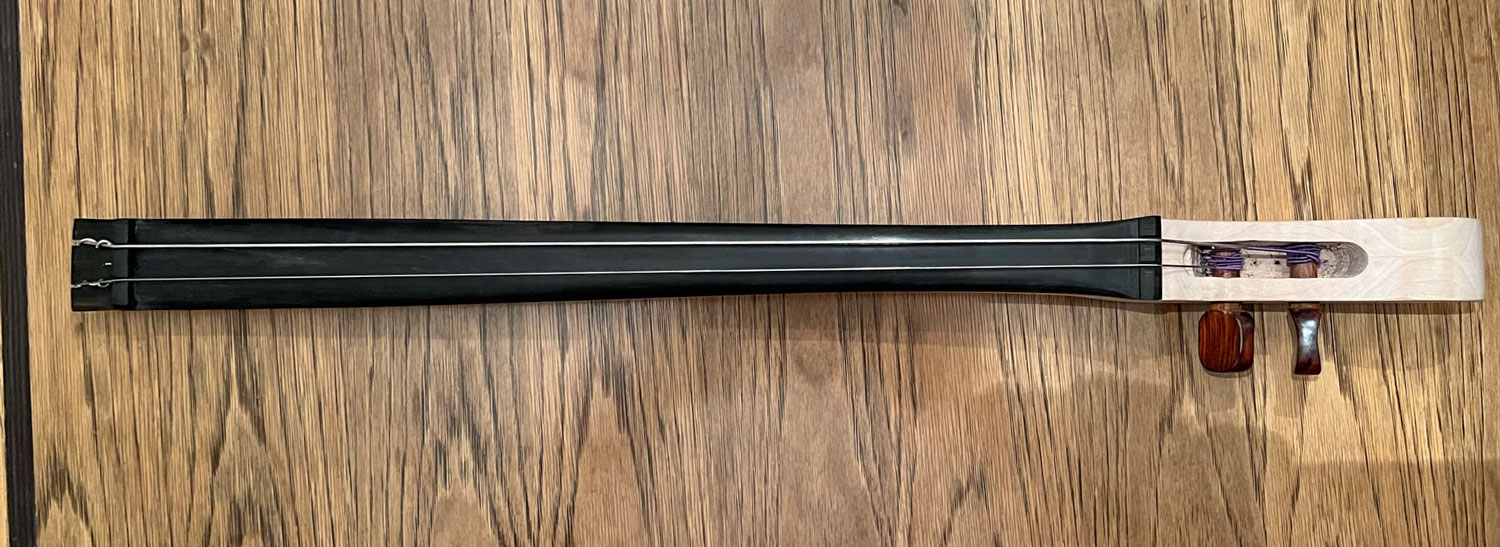
It has only two strings, an A string and a D string, but it allows her to run her fingers along the strings, maintaining her strength and calluses, and doing imaginary exercises. The strings are tight but not "in tune", and no sound is produced. While it works, Judy would prefer one with four strings, and I'll work on that when we get home.
Now, back to our trip.
11/5/2022 (Saturday) We arrived at Limassol, Cyprus later in the morning today. The port terminal building was impressive, very modern. Unfortunately, I didn't take a picture from the ship:-( but I was able to find one on the web.
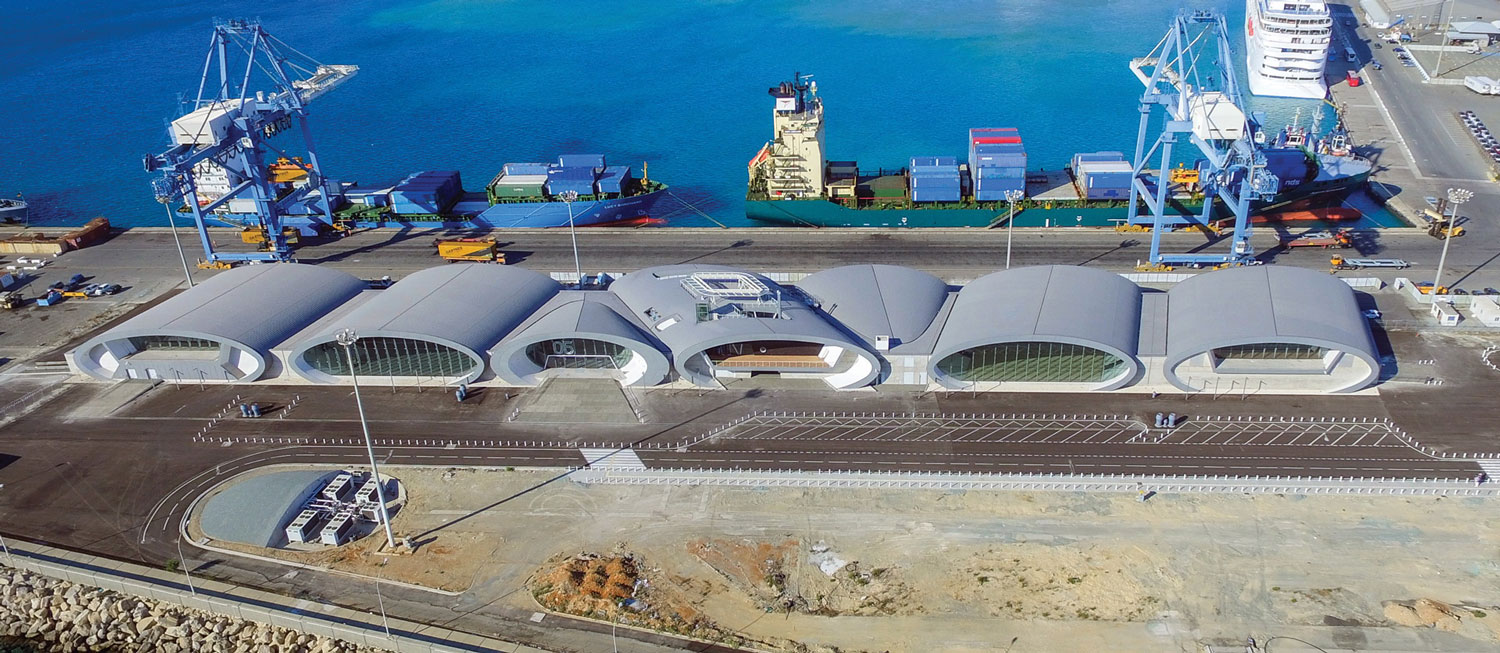
We are on a small group tour and had a small bus. Choosing the small group proved not to be the best decision. The seats on the small bus were not that comfortable, and they were tight to the seat in front of them. Also, the ride was somewhat harsh. We would have been much more comfortable with a larger group on a big bus.
Additionally, our driver was a wild man, driving fast, and making turns at too high a speed. It was not a comfortable excursion.
Our tour started at the Kourion Archaeological site. The site is quite large and we only covered a small amount of it. Here's a map of the site.
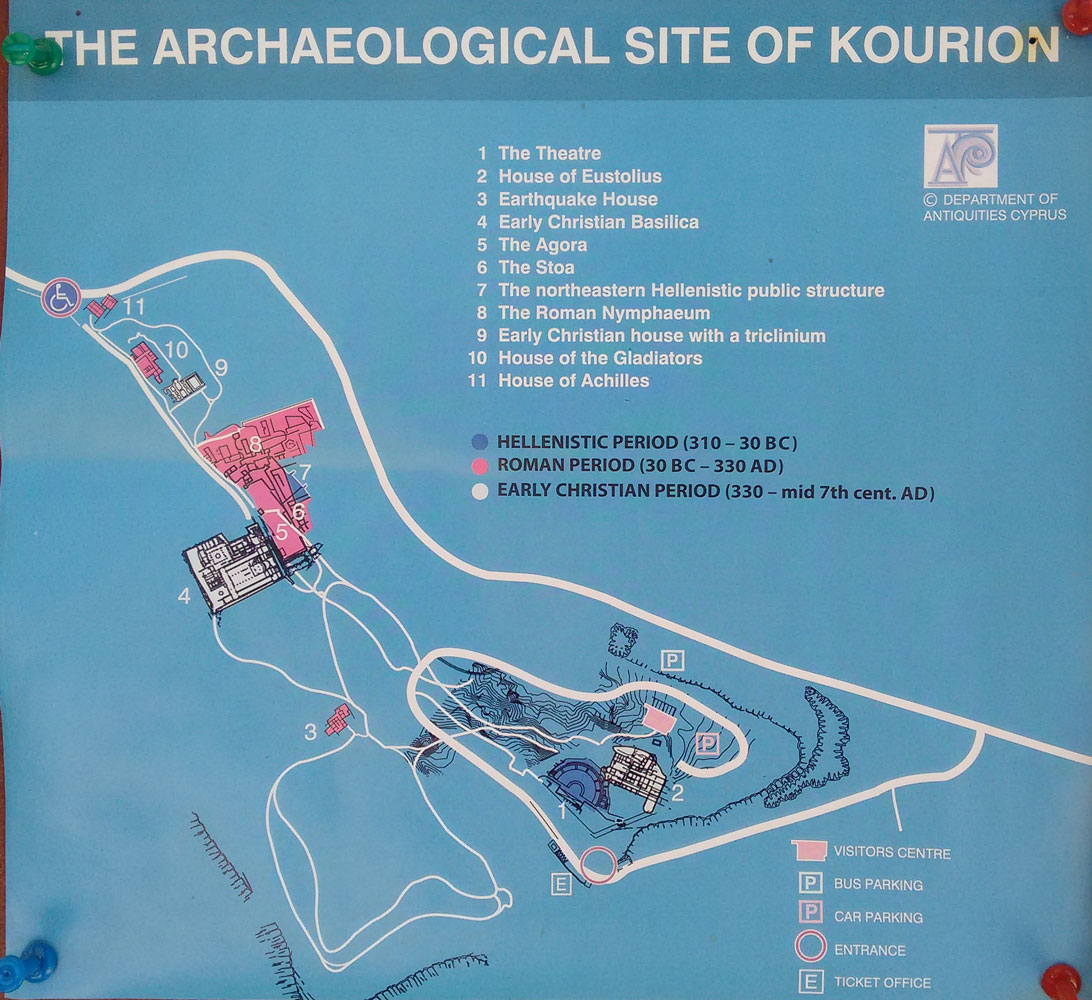
We started at the House and Baths of Eustolios, which is item 2 on the map above. They've built a structure over it to protect the site.
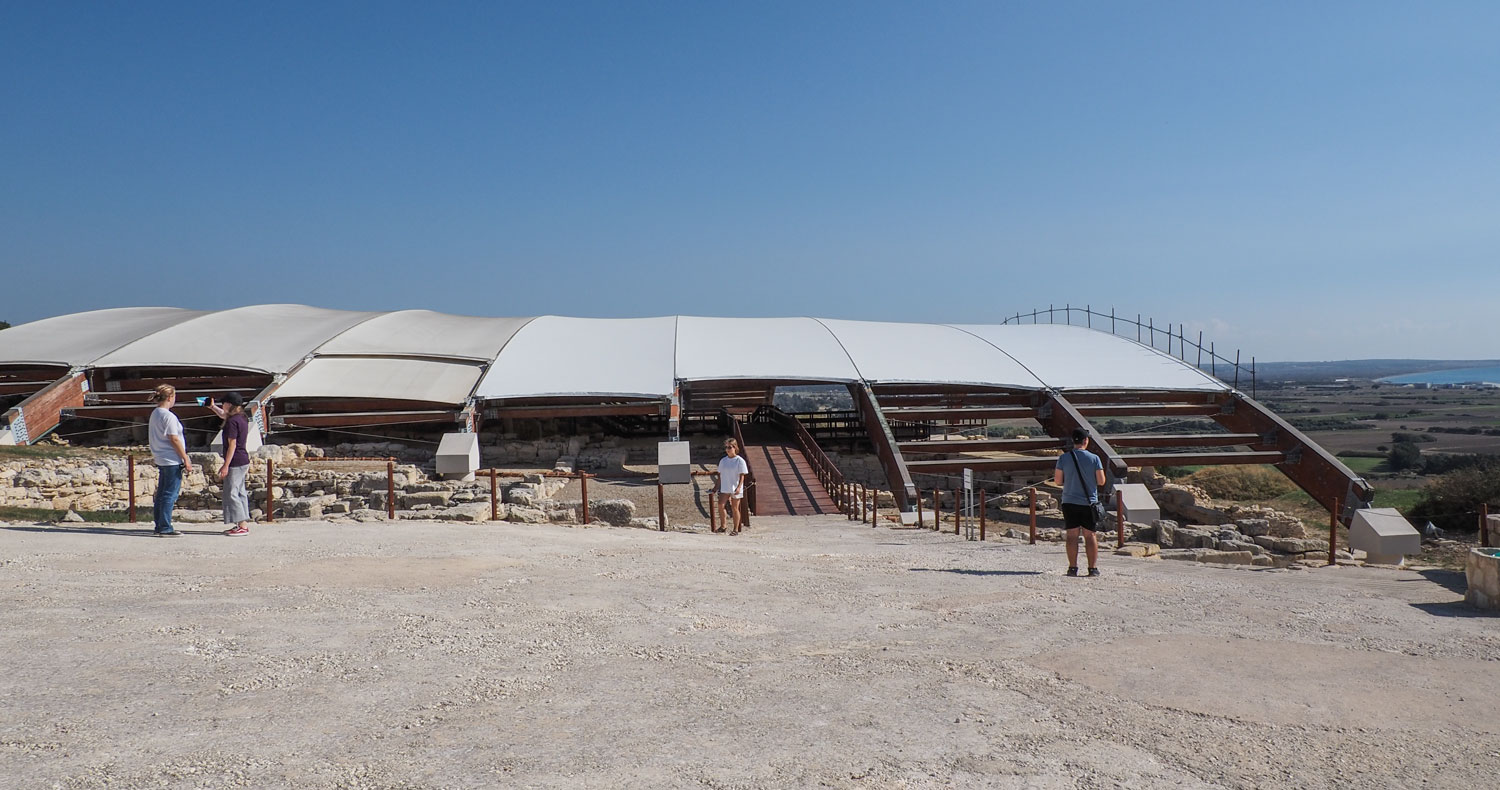
There's not a lot to the site - it's been fairly well destroyed.
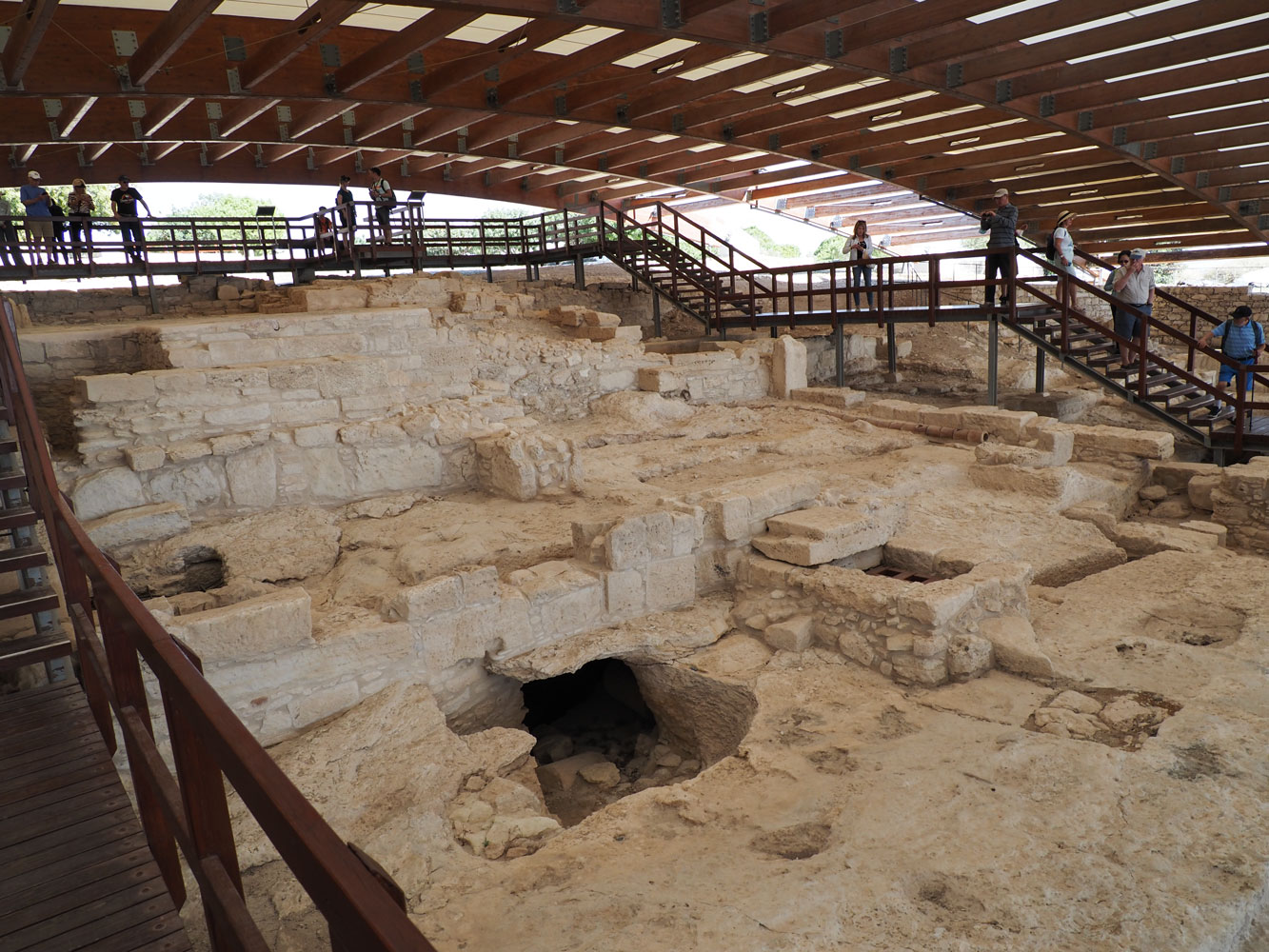
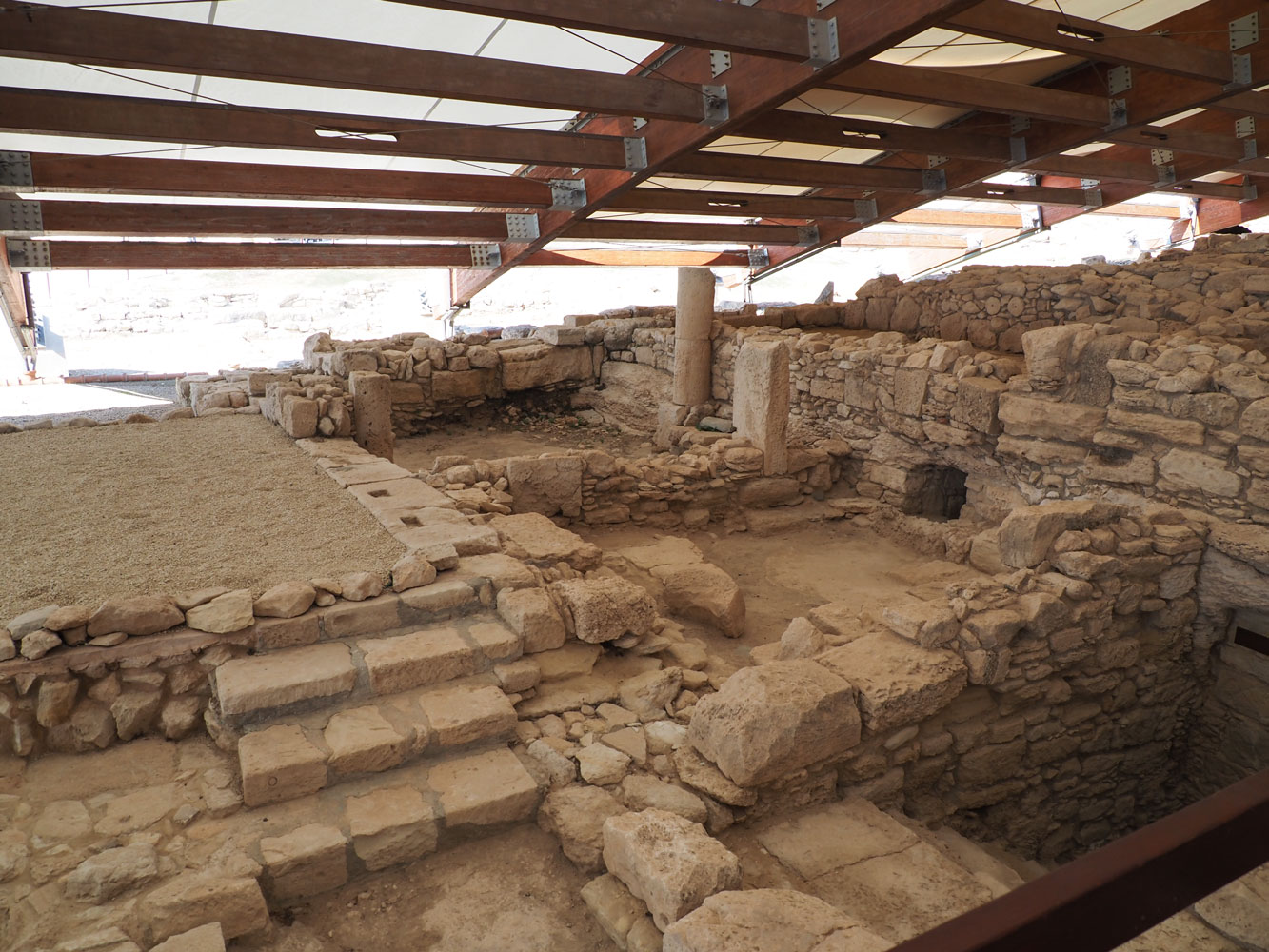
There was a mosaic in the home.

A closer view of part of the mosaic.
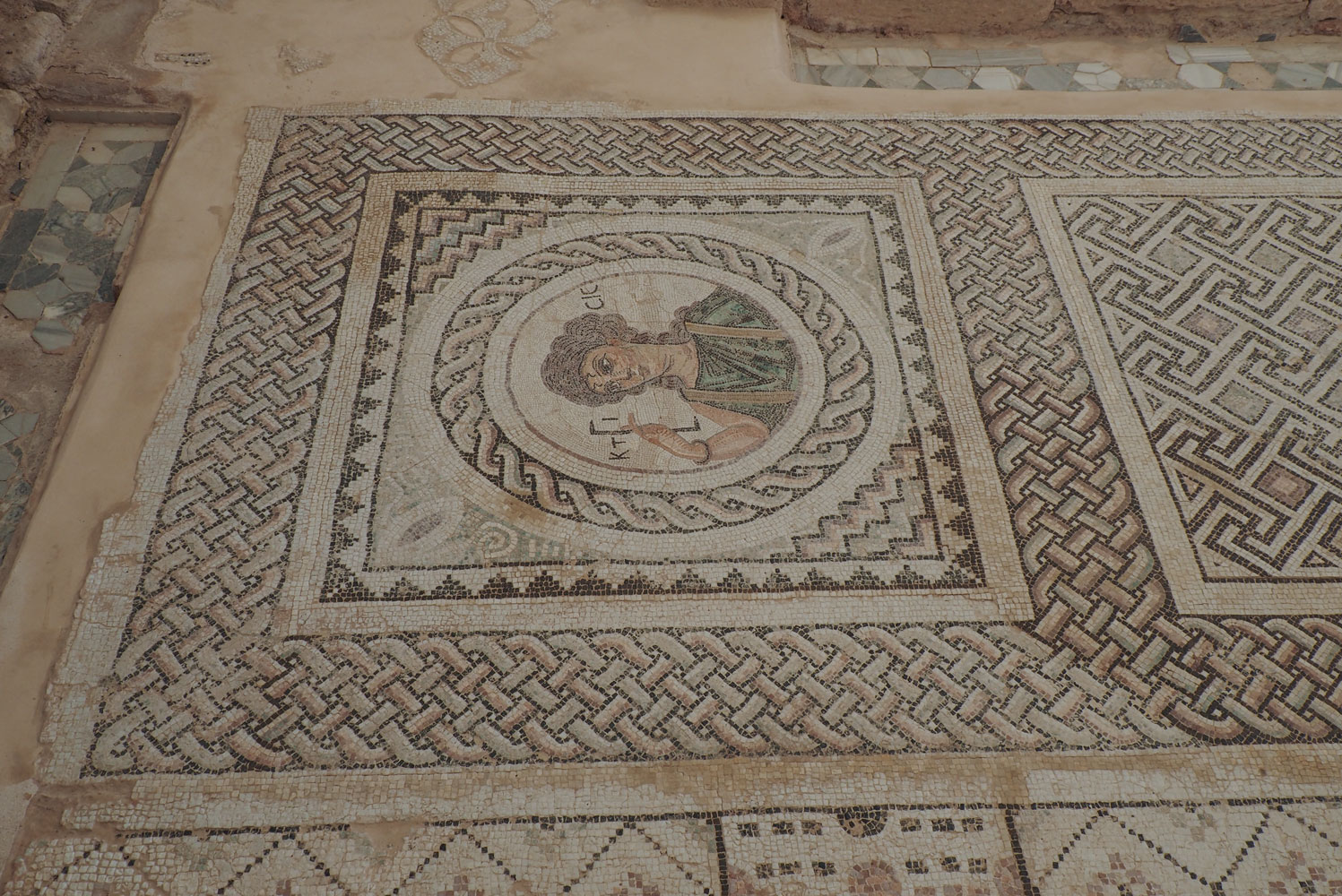
Then we went to the theatre, which is item 1 on the map. It's modern, probably rebuilt on the site of the original theatre.
Here's a panoramic picture of the theatre.
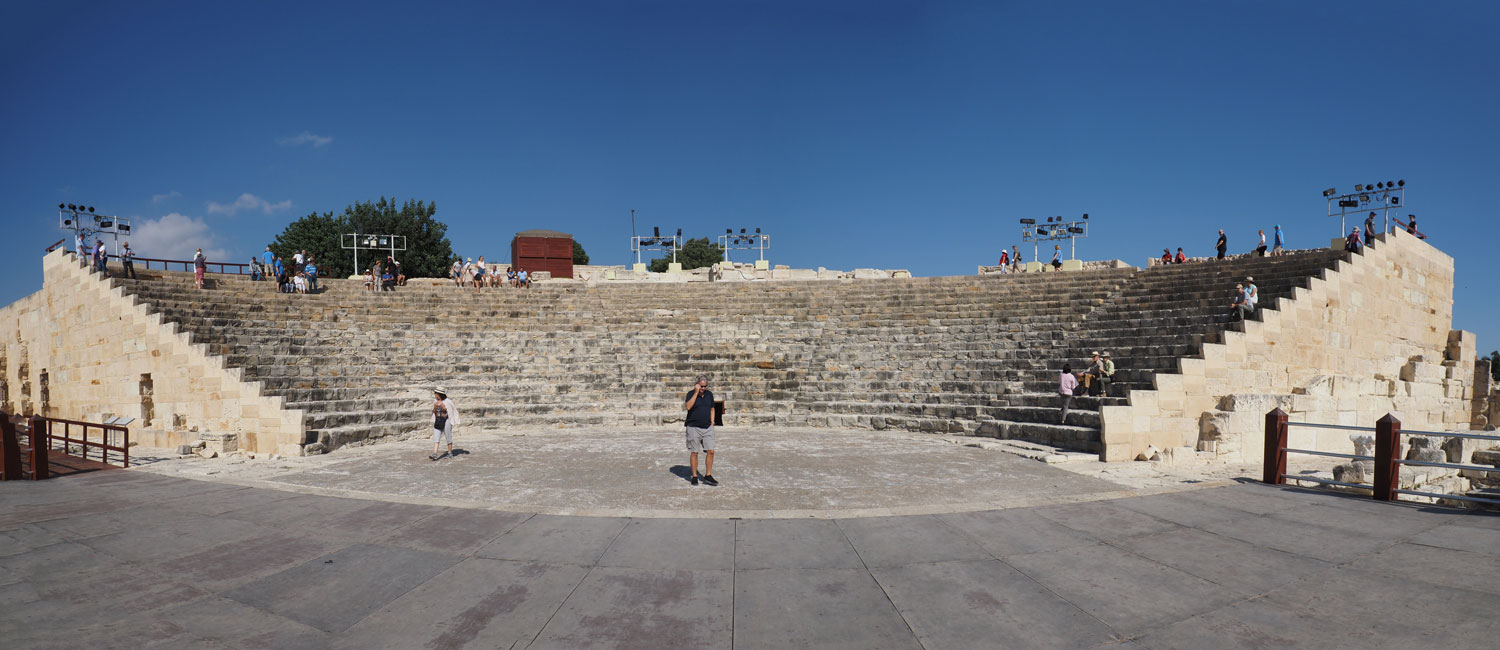
Then we boarded the bus and went about 4 km west to the Sanctuary of Apollo Hylates. Here's a map of the site.
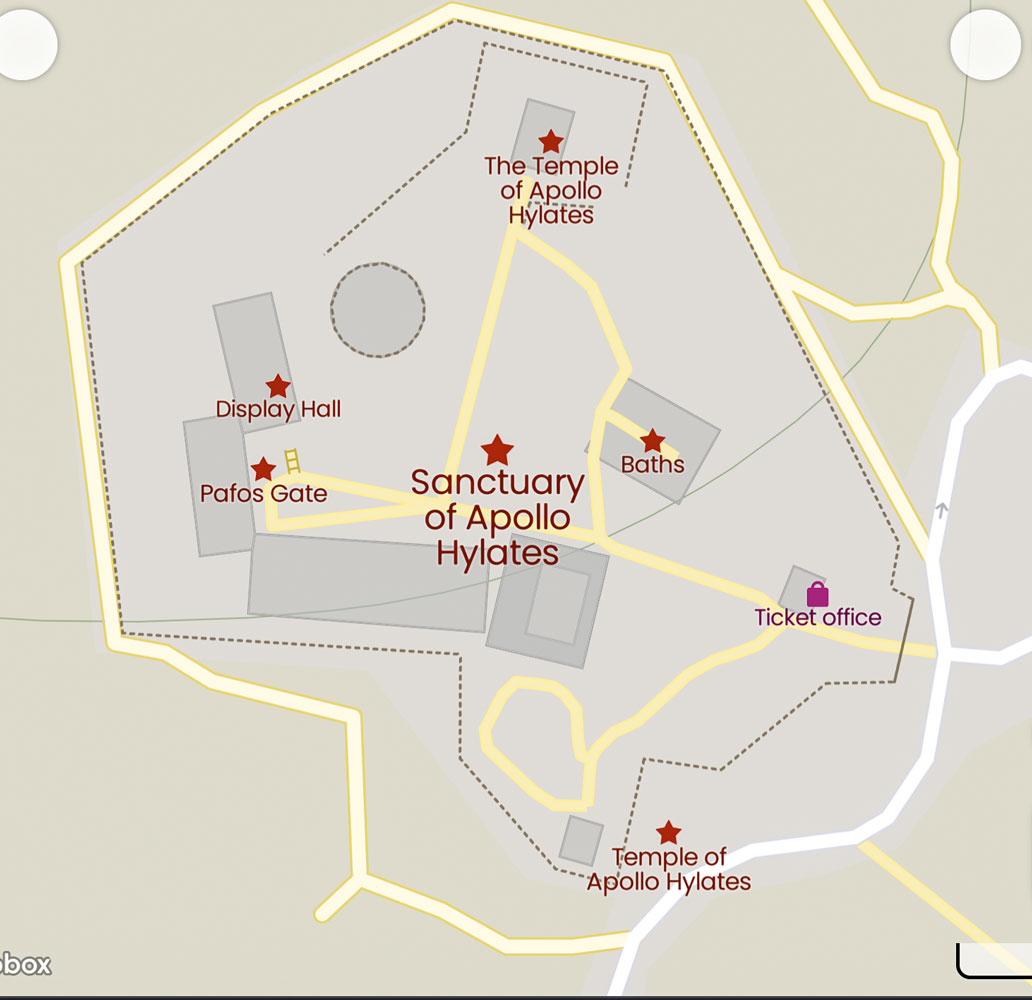
The view entering the site.
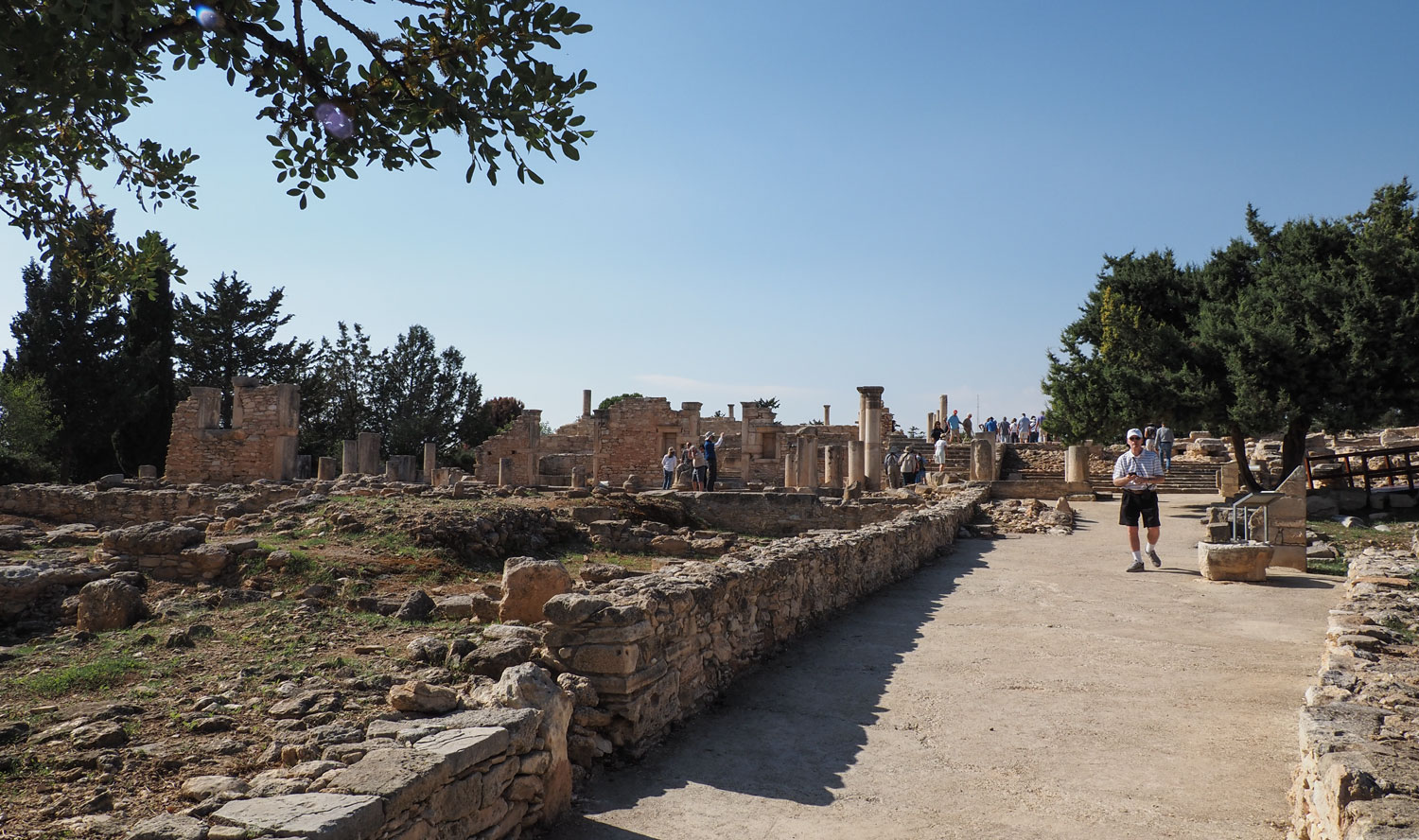
The signature item at the site is this reconstruction of part of the Apollo temple.
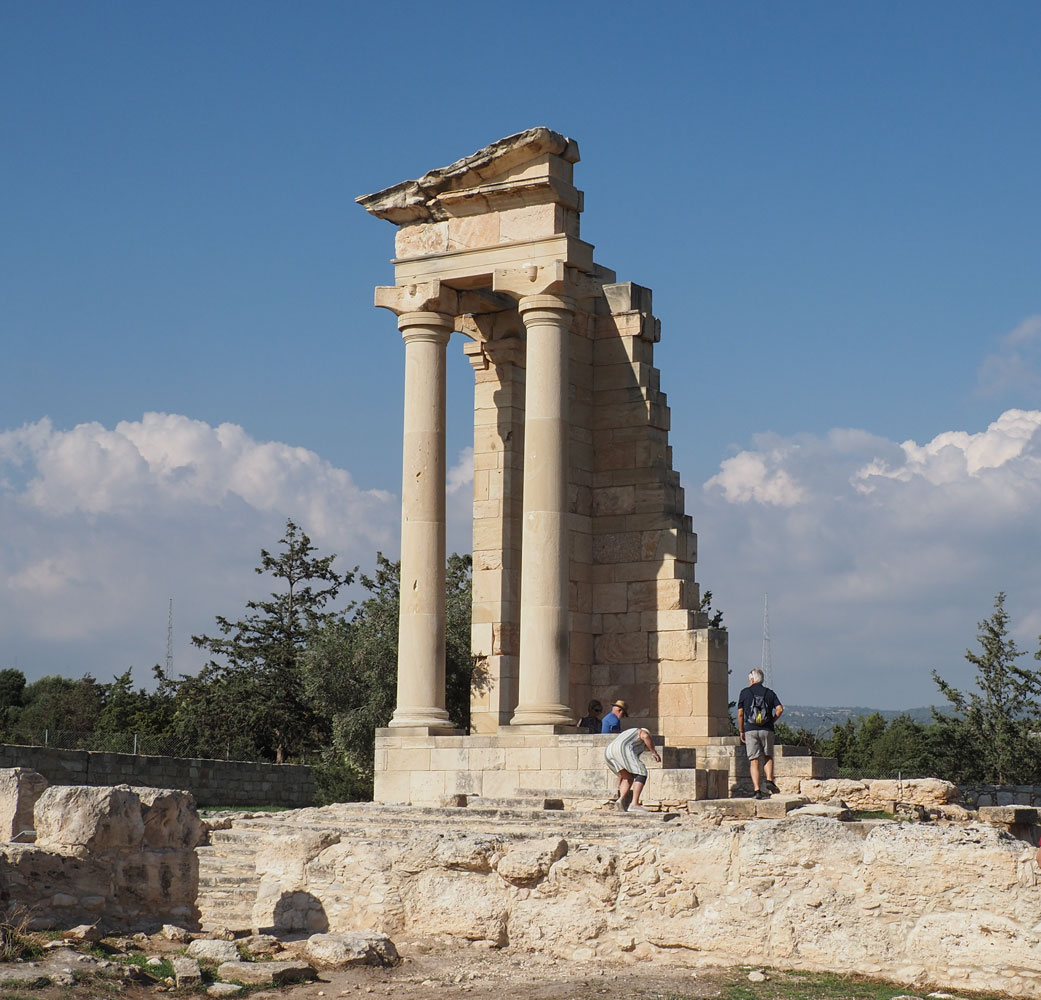
Judy in front of the temple.
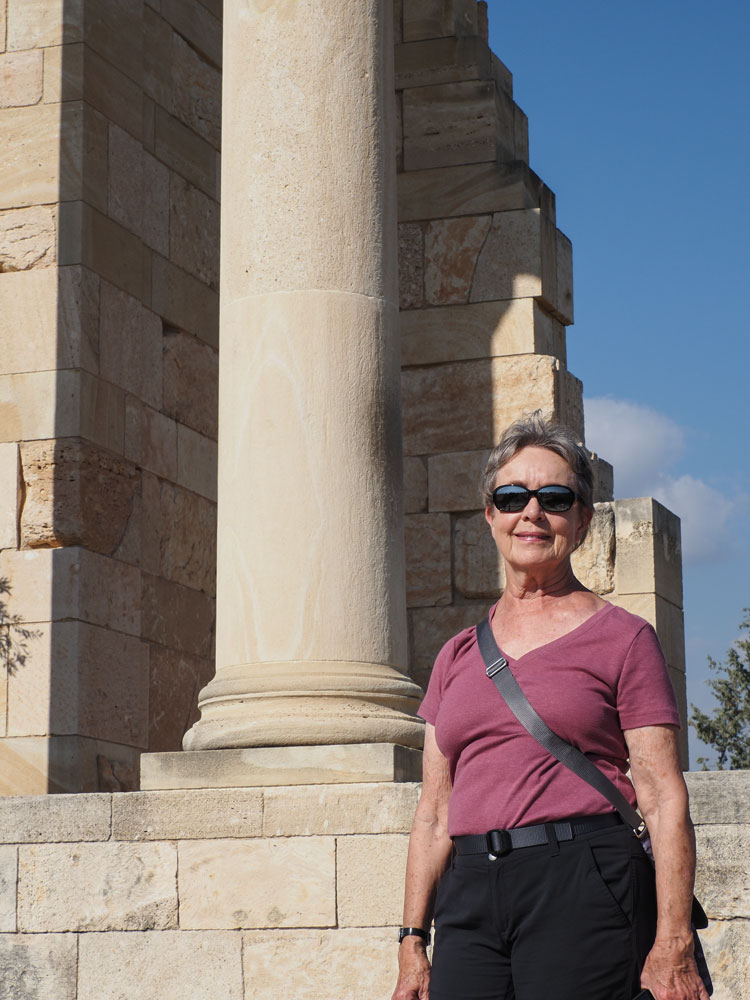
And me.
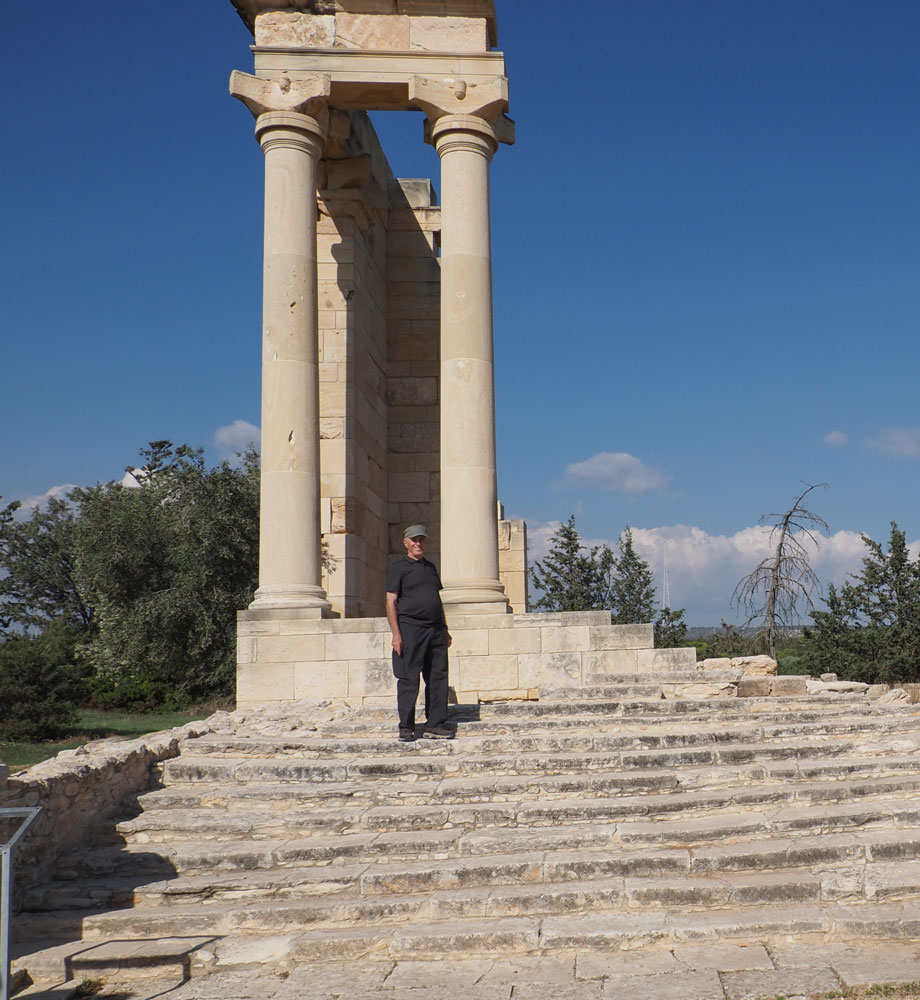
There's not a lot to see at the site - just a bunch of stones. I think Judy and I were getting overdosed on ruins by this time.
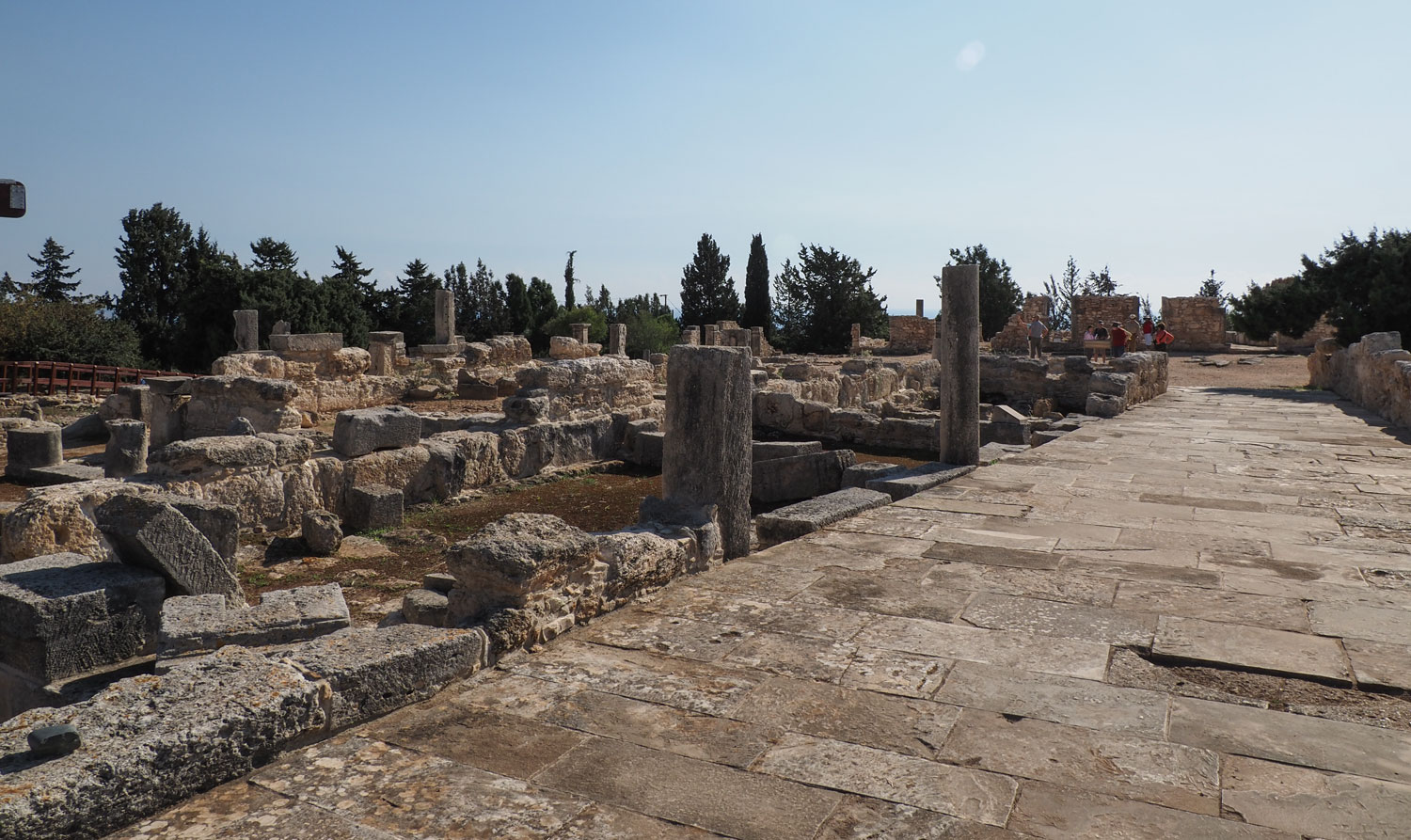
We left the Sanctuary of Apollo and took the bus to Omodos, a small town in the mountains. We began our visit in the Monastery of the Holy Cross. Here's the entrance to the church.
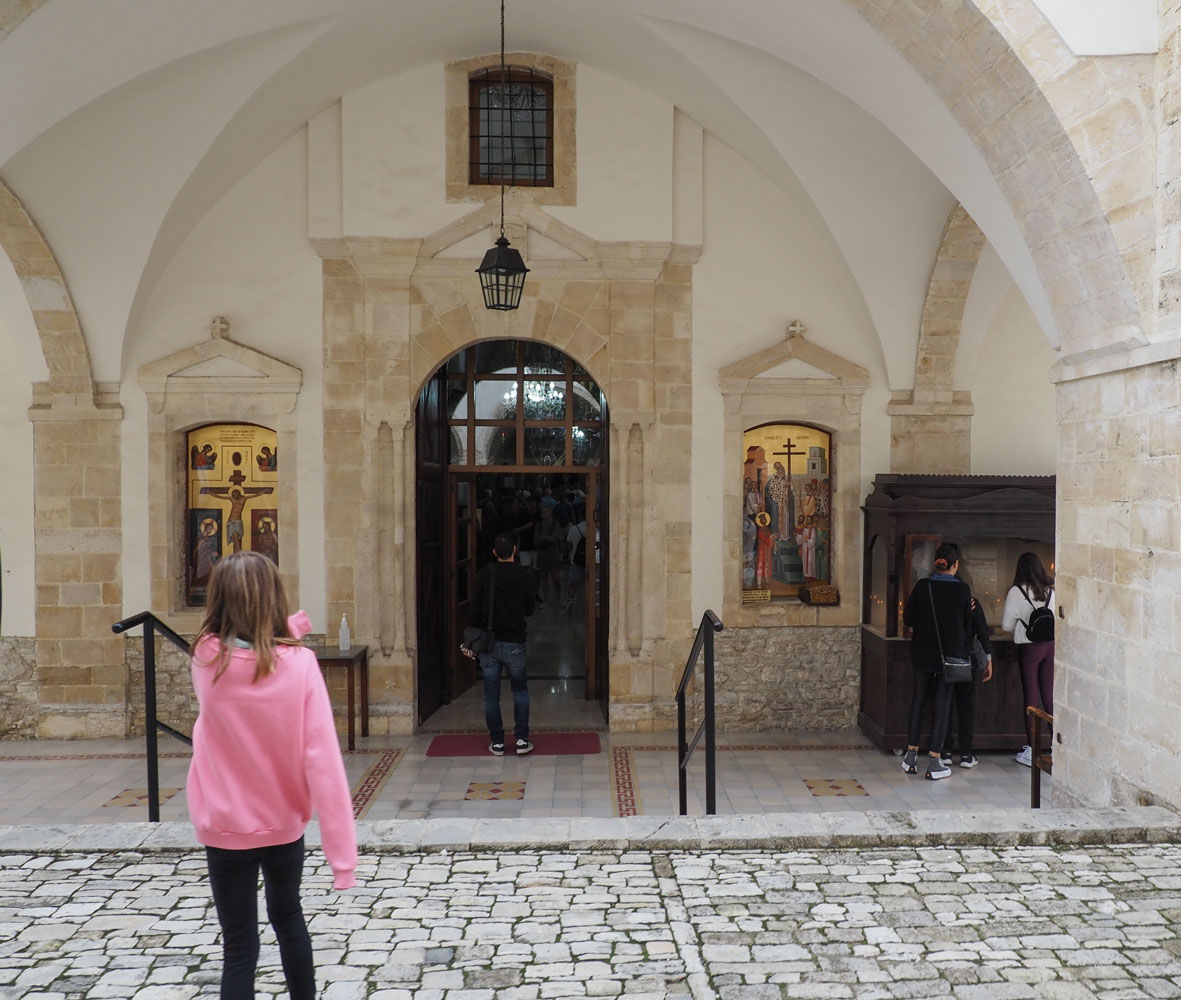
The highly decorated altar.
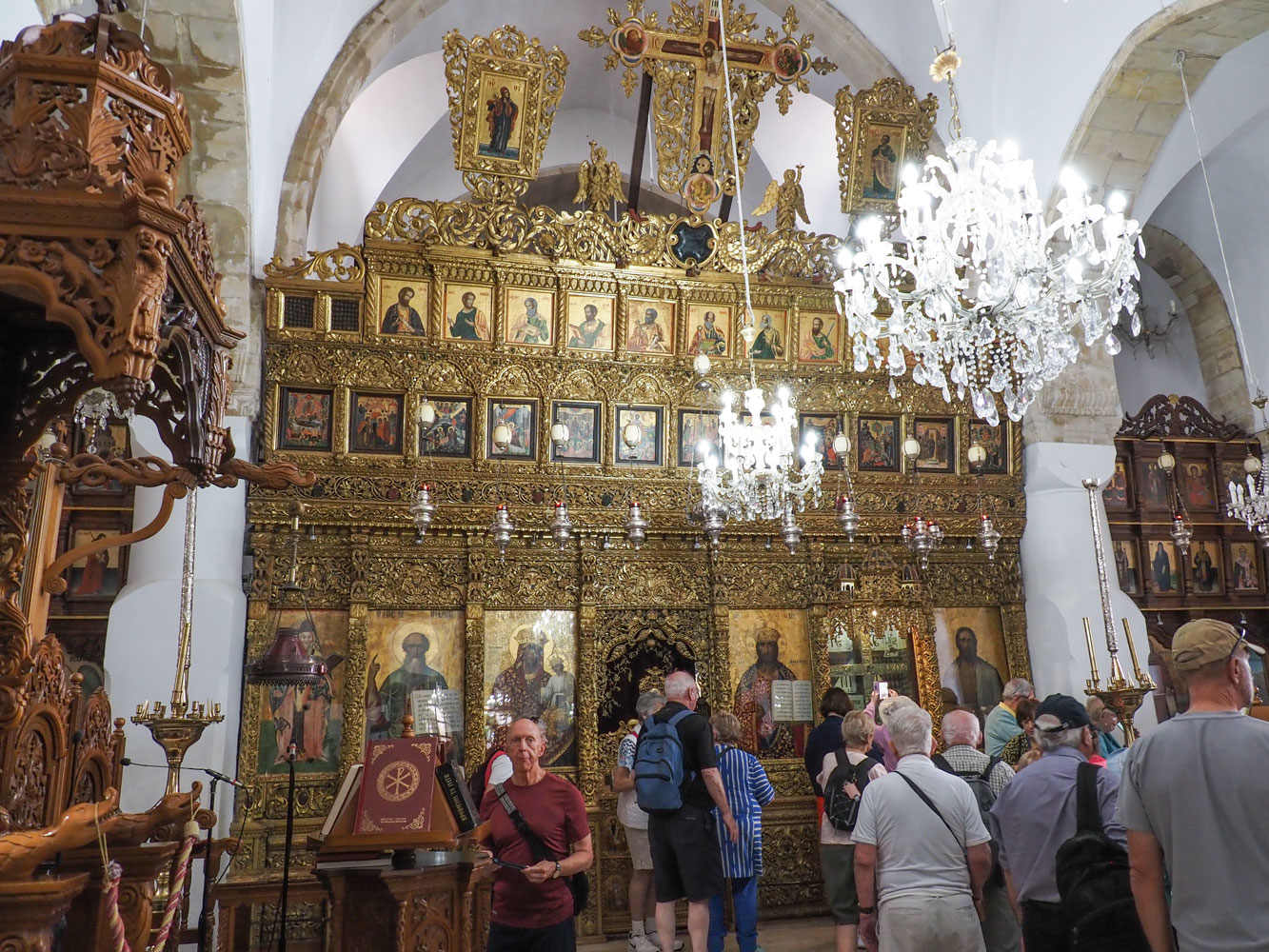
I don't know what this would be called, it's probably for the minister to use during the services. Very highly decorated, especially with carvings.

A detail from the altar. I think this is supposed to contain a piece of the authentic cross of Jesus. However, back in ancient times, provenance was not investigated and there were a lot of pieces of the authentic cross. Someone once commented that if all the pieces of the authentic cross were collected in one place, you could build a house.

A mosaic of the symbol of the church, a two headed eagle.
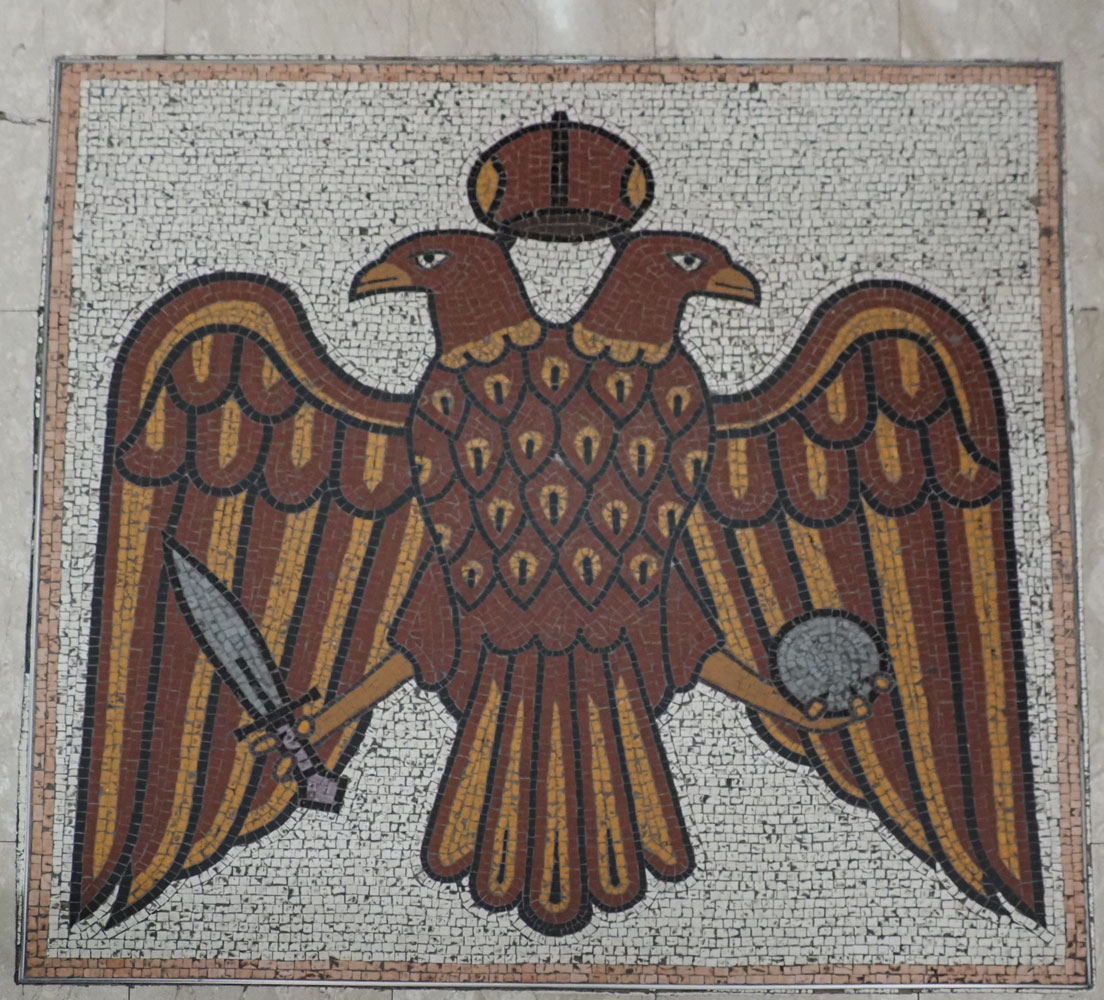
When we left the church, we went to a small winery and did a tasting. They also sold olive oil.
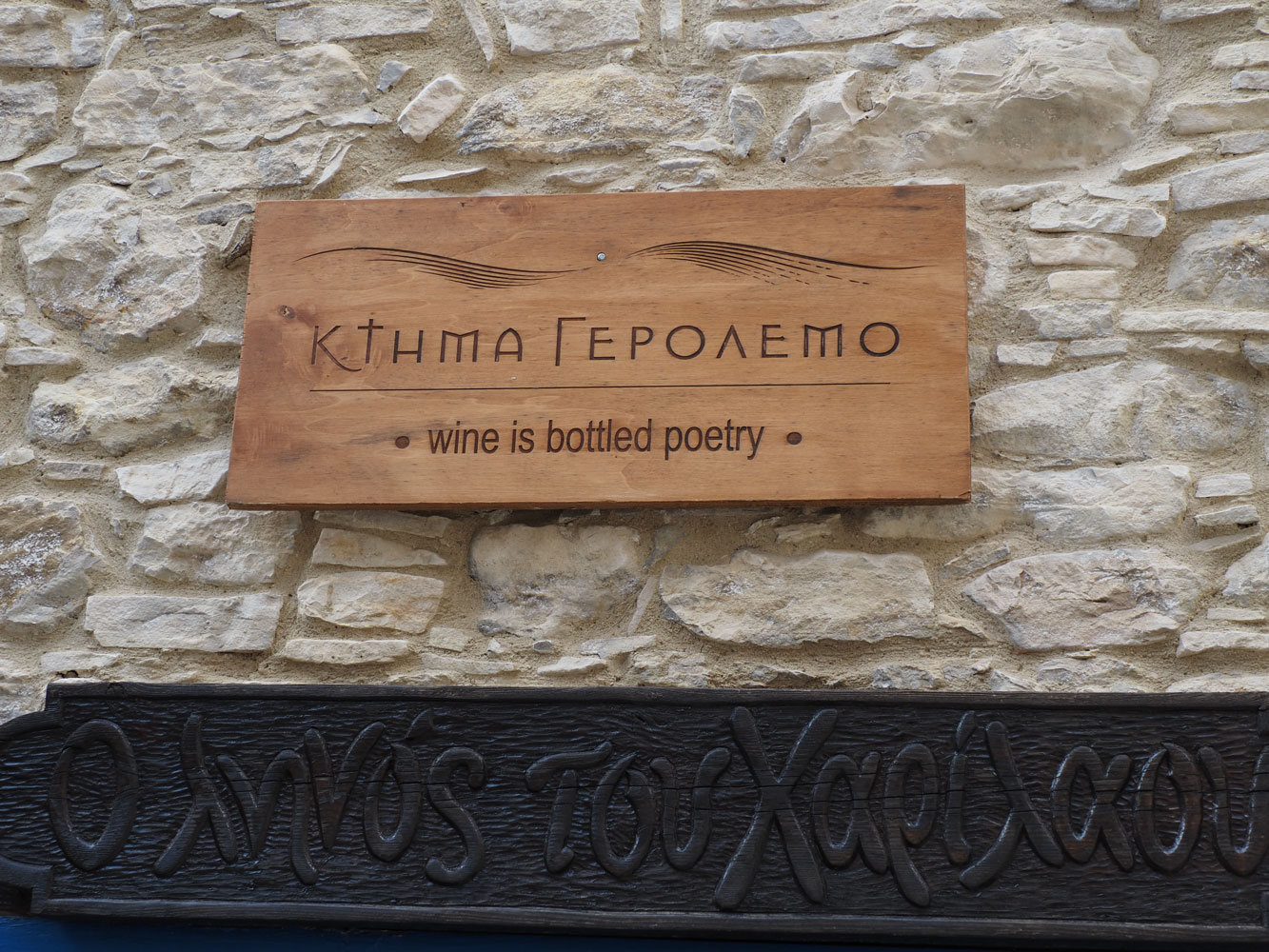
A few members of our group at the tasting.
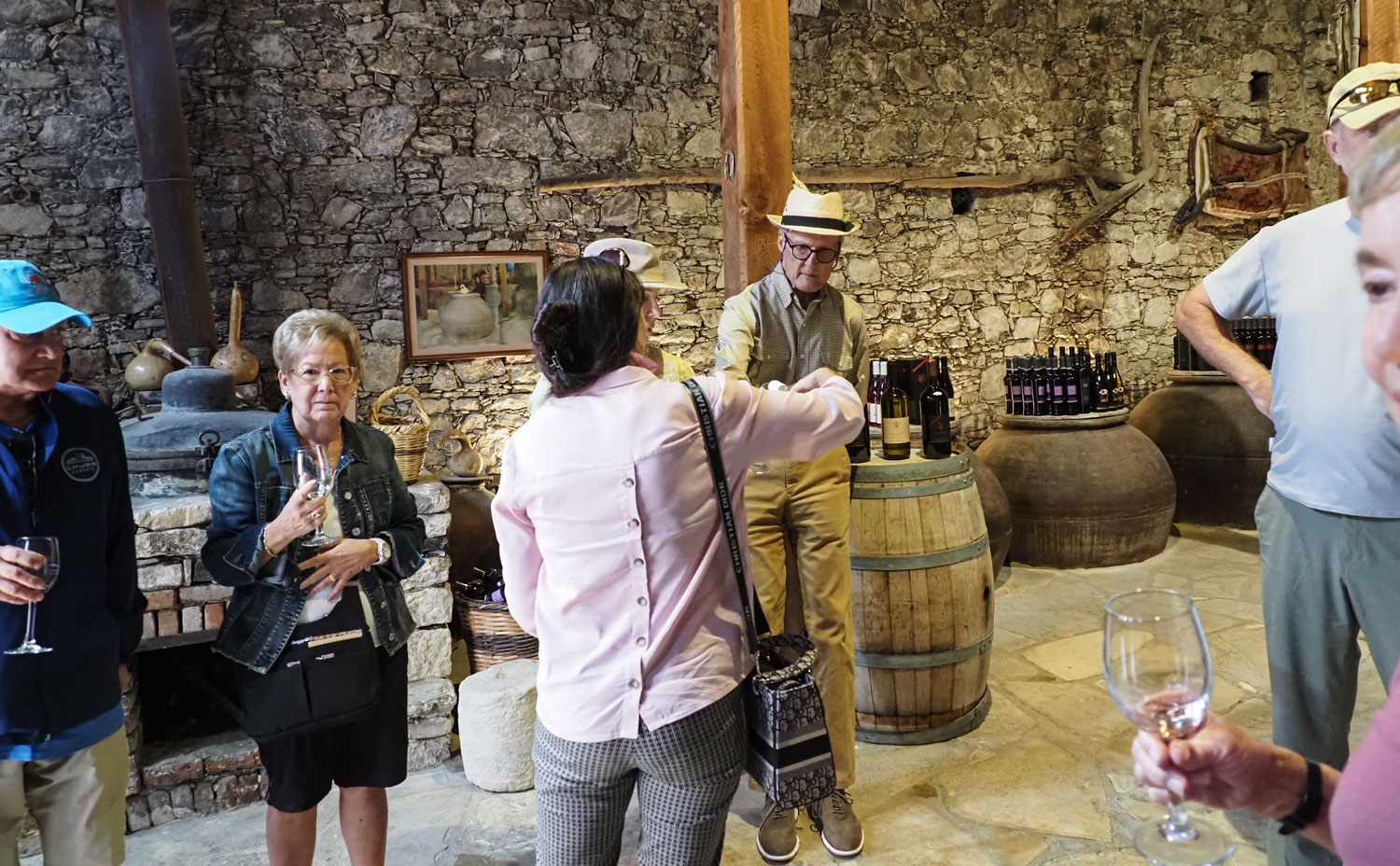
Judy and I bought a bottle of dessert wine and some olive oil. Then it was back to the ship.
We had dinner, and that was the end of our day. Tomorrow we go to Haifa.
+++++++++++++++++++++++++++++++++++++++++++++
11/6/2022 (Sunday) Let me start this section by trying to give some history of Israel. First, Israel is a Jewish nation and Judaism is an inherited religion. That is, the Jews believe that the children of Abraham are the chosen of God. To be a Jew, you must be a descendent of Abraham, i.e., be a child of Jewish parents (technically, be born of a Jewish mother - the father doesn't matter). Both Christianity and Islam are outgrowths of Judaism, after all, Jesus was a Jew, but Islam treats Jesus as a prophet and not as the son of God.
The state of Israel grew out of modern Zionism in the late 19th century, but especially from the efforts of Theodore Herzl in the late 1800's. While Herzl died in 1904, it was because of the movement he created that the Balfour Declaration, promising England's support for a Jewish homeland, was issued in 1917.
After WWI, Britain had the mandate for Palestine. While some Jews had settled in Palestine prior to WWI (about 60,000), more came after the British mandate - close to a half million between WWI and the start of WWII. After WWII, more Jews came to Palestine even though the British attempted to limit Jewish immigration. By May 1948, when Israel declared its independence, there were about 800,000 Jews in the country. See here for more information about immigration to the land of Israel.
The current population is close to 9 million of which Jews are about 70-80%. There are less than 20 million Jews, worldwide, and about half live in the US.
The Declaration of Independence initiated the War for Independence in which the armies of Egypt, Jordan, Iraq, Syria and Lebanon attacked Israel. The war continued until February 1949 when separate armistices were signed between Israel and the Arab countries.
Tension with the surrounding Arab countries continued and led to Six Day War, and the Yom Kippur War.
There's a lot more to the history of modern Israel but this will do for a short summary.
++++++++++++++++++++++++++++++++
We arrived at Haifa this morning and boarded a bus for Safed and the Golan Heights. Here are our friends Kathleen and Keith who are on the tour with us.
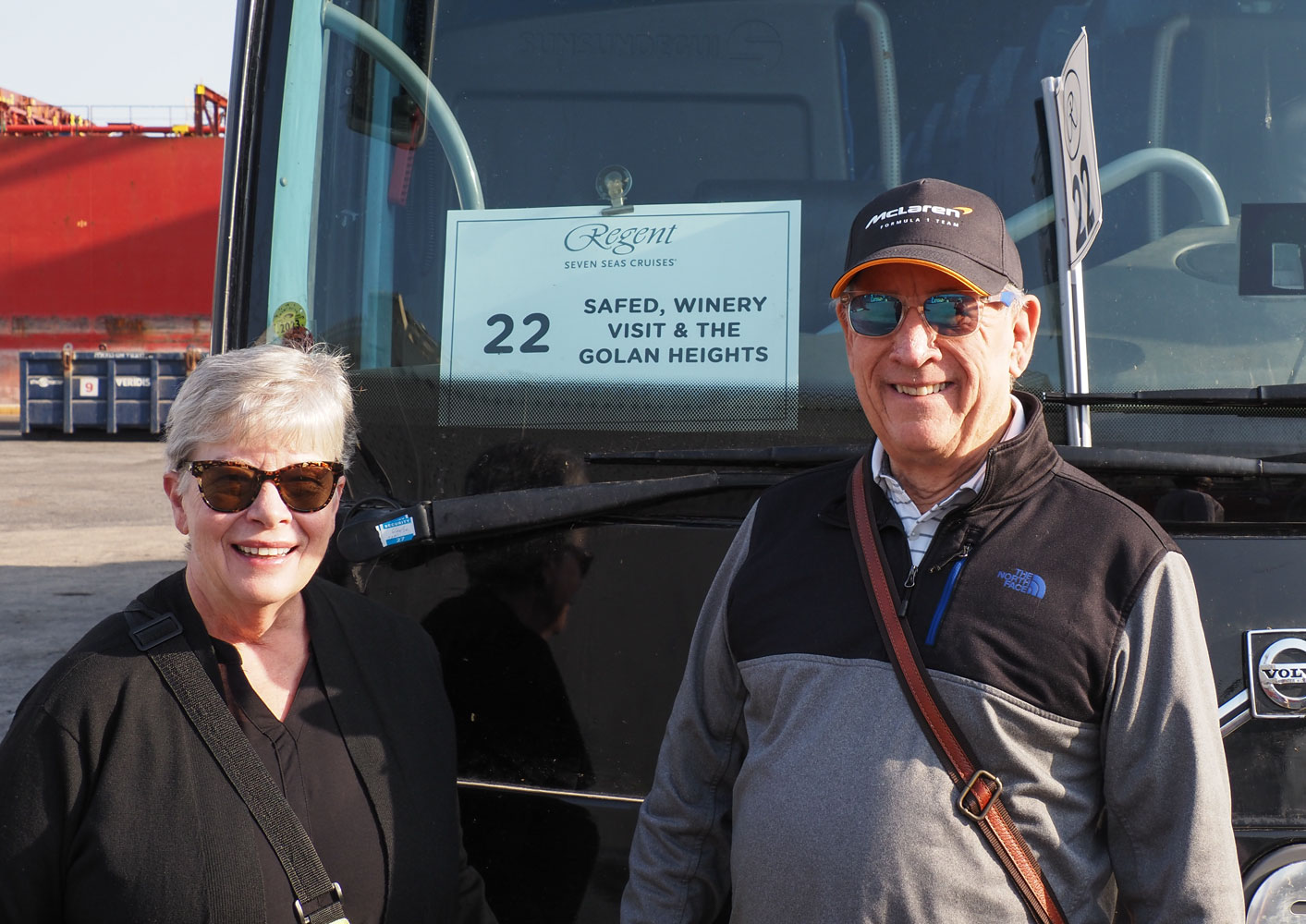
It was about an hour and a half drive to Safed.
Safed is built on a hillside, so there are lots of ups and downs in the town.
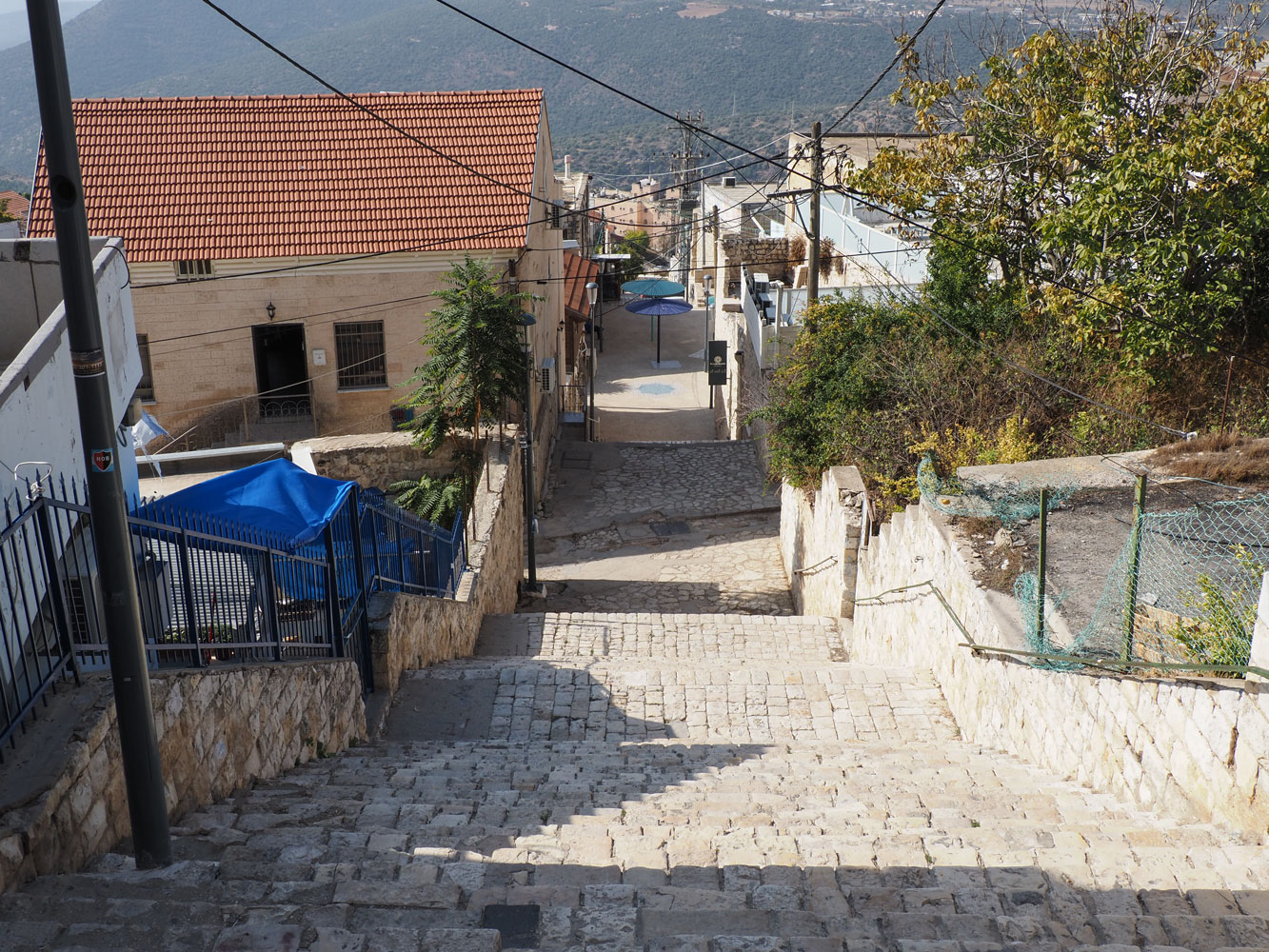
During the War for Independence the Jews of Safed were attacked by the Arab population. With the help of the Haganah they were able to capture the three strategic buildings in the town. Here's a picture of one of the buildings, the police building. They've left the bullet pock marks from that battle.

The Arabs of the town evacuated, expecting that the Arab armies would soon come to liberate the town, and they could return to their homes. That didn't happen, of course, and they became part of the refuges living in the West Bank or Jordan.
After a restroom stop, we went to the Abuhav Synagogue.
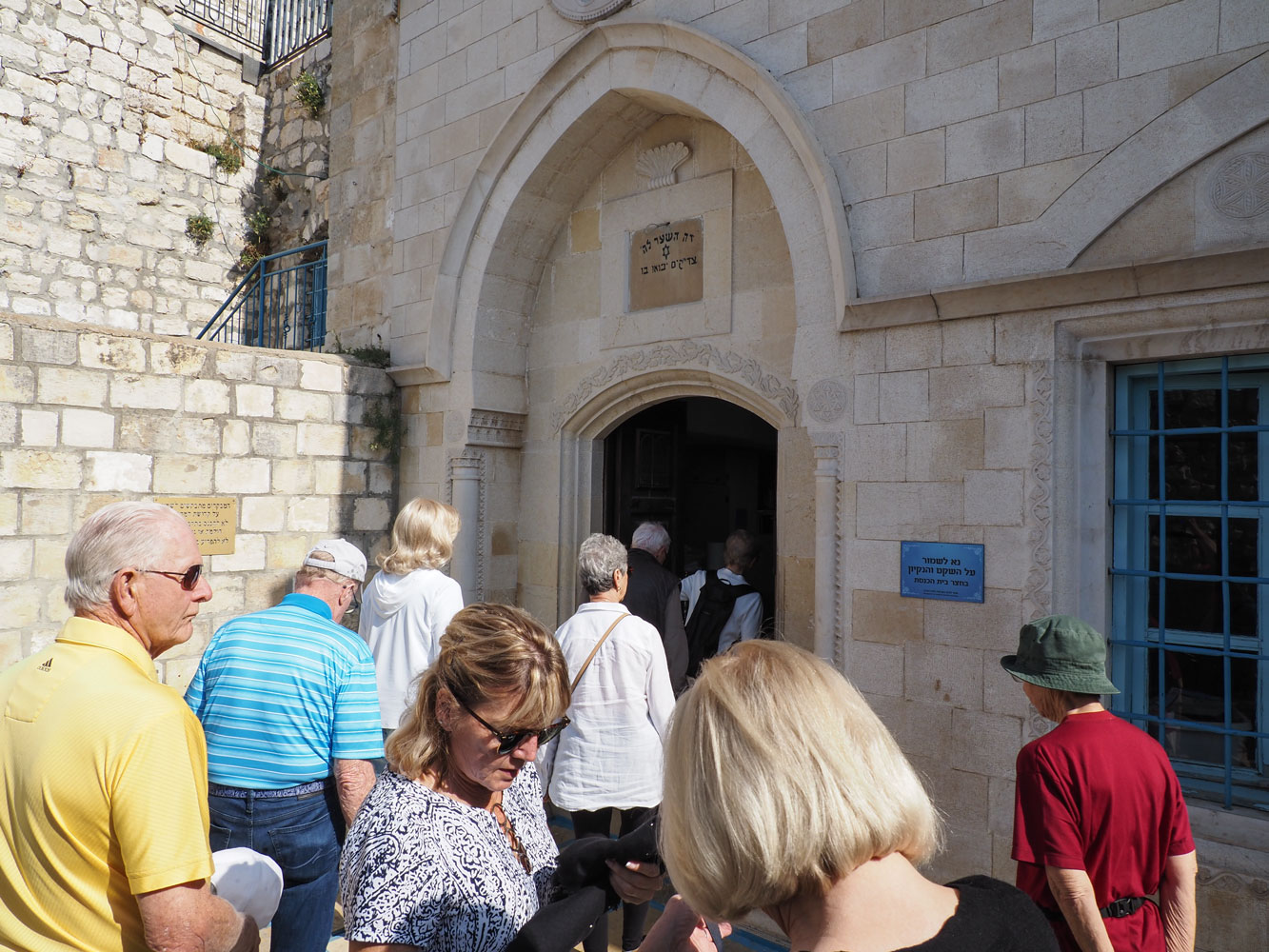
An interior view showing the bimah.

The ceiling.
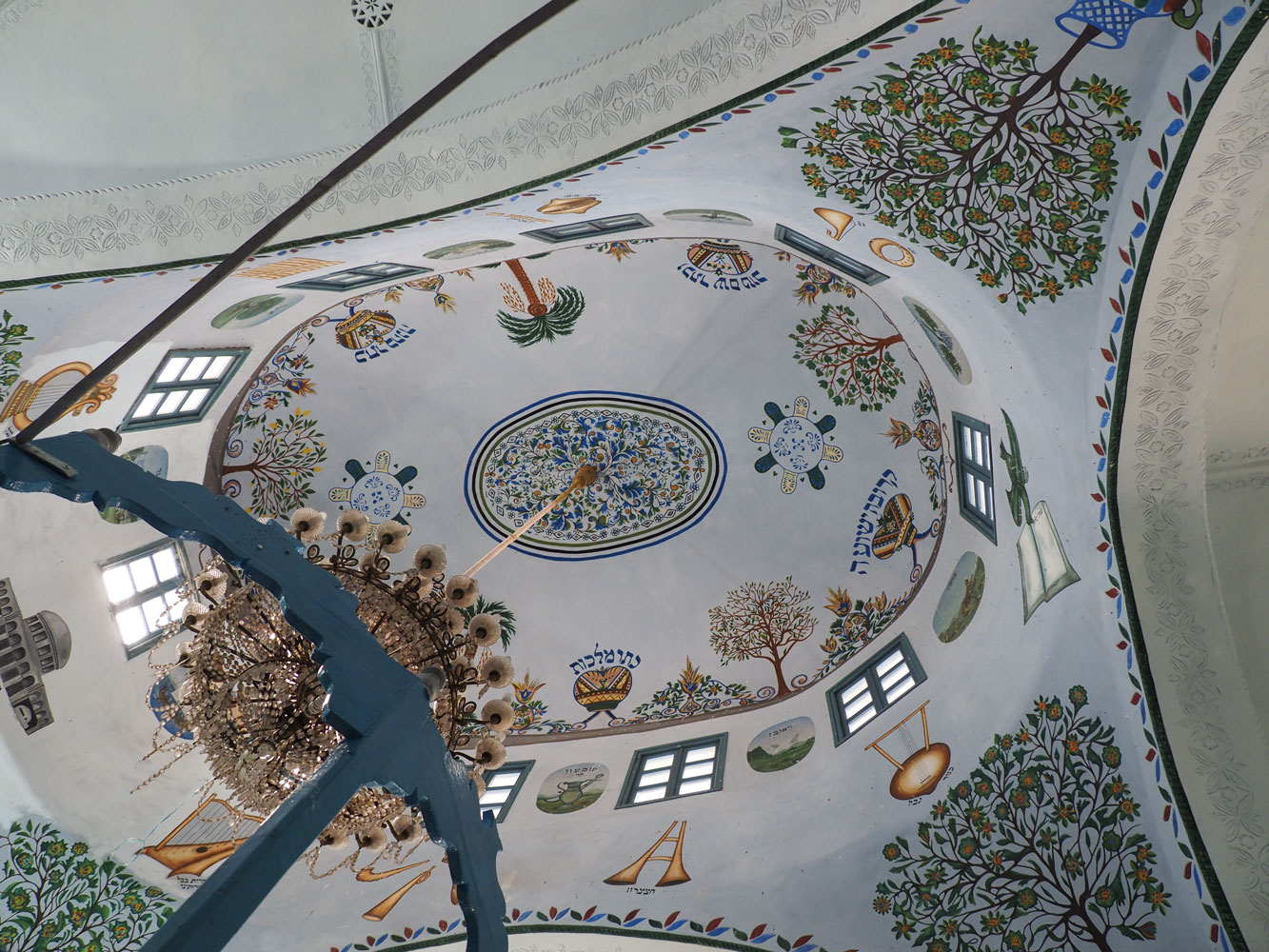
The Holy Ark.
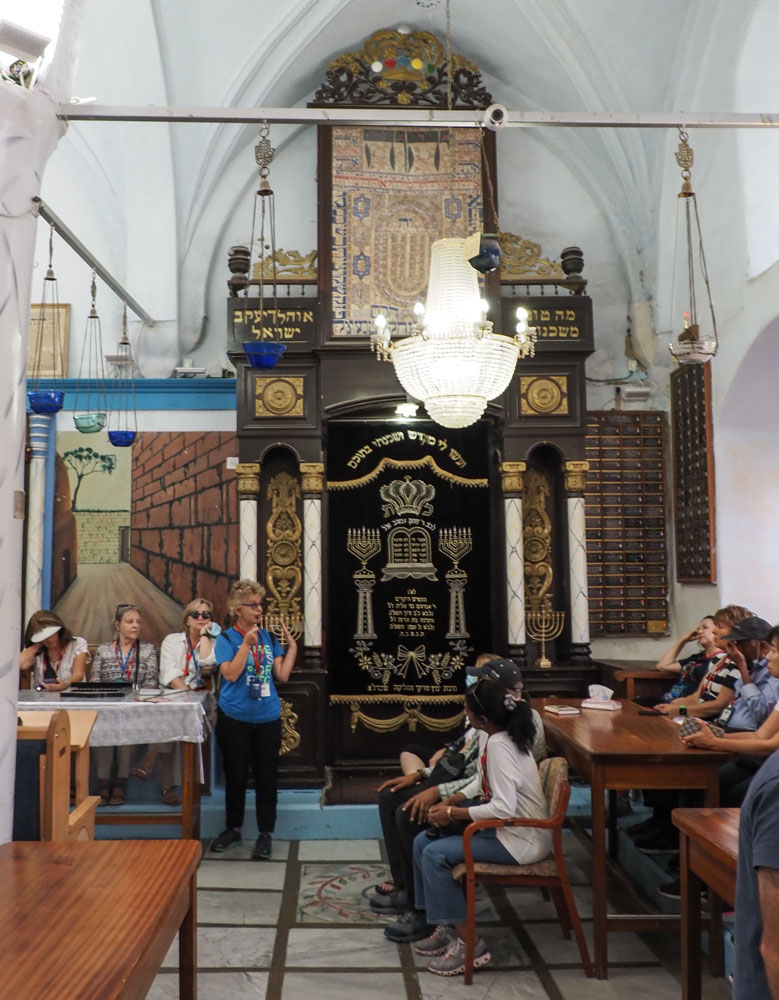
Then we left Safed and headed to a winery for a tasting. However, neither the driver nor the tour director could find the winery. We drove in circles for about 20 minutes until the winery owner came in his car and led us to the winery.

Here's the group at the winery. I didn't care for the wines - I don't think anyone bought any.

After we left the winery we headed to lunch. At the entrance to a kibbutz we passed on the way to lunch was a tank. The Kibbutz Degania Alef (also known as Kibbutz Dan - I think it was the first kibbutz in Israel) displays this Renault R35 tank as an historical reminder.
This tank was one of five which attacked the kibbutz during the War of Independence. The story of how the members of the kibbutz stopped the attack vary, but stop them they did. You can read about the battle here.
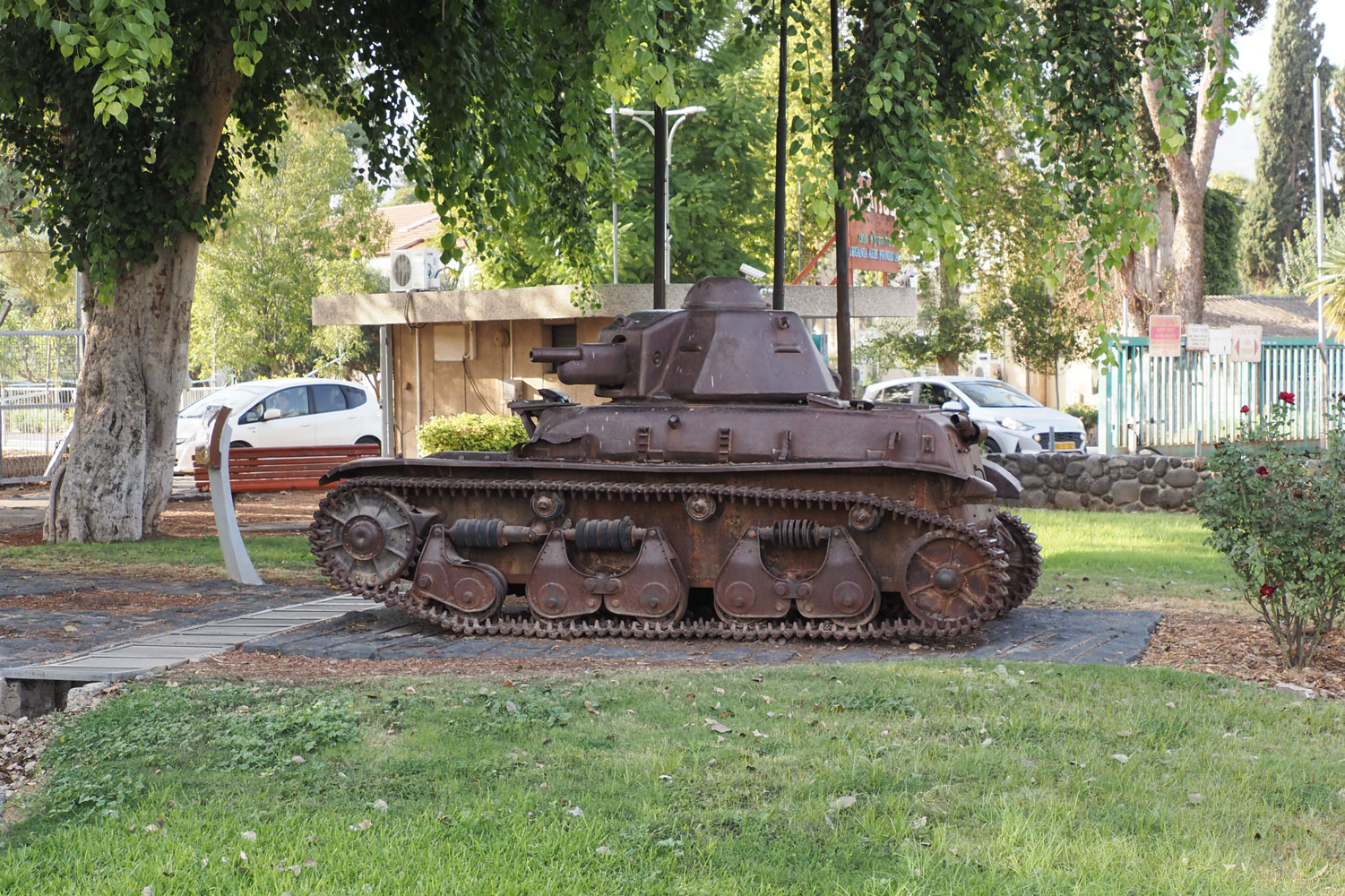
Just a few hundred meters down the road from Kibbutz Dan is the Har Vagai School, located on Kibbutz Dafna and that's where we went for lunch.
Here's a panoramic view of the dining hall.
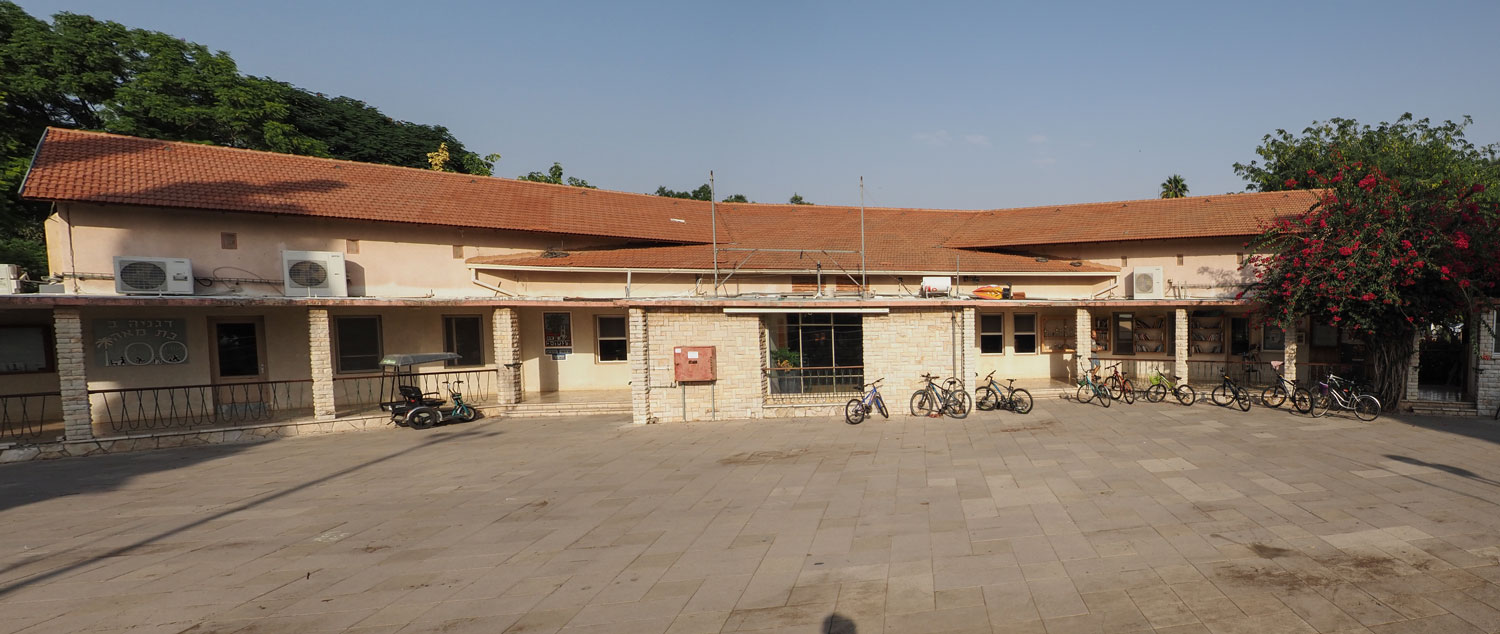
Some of our group in the dining hall.
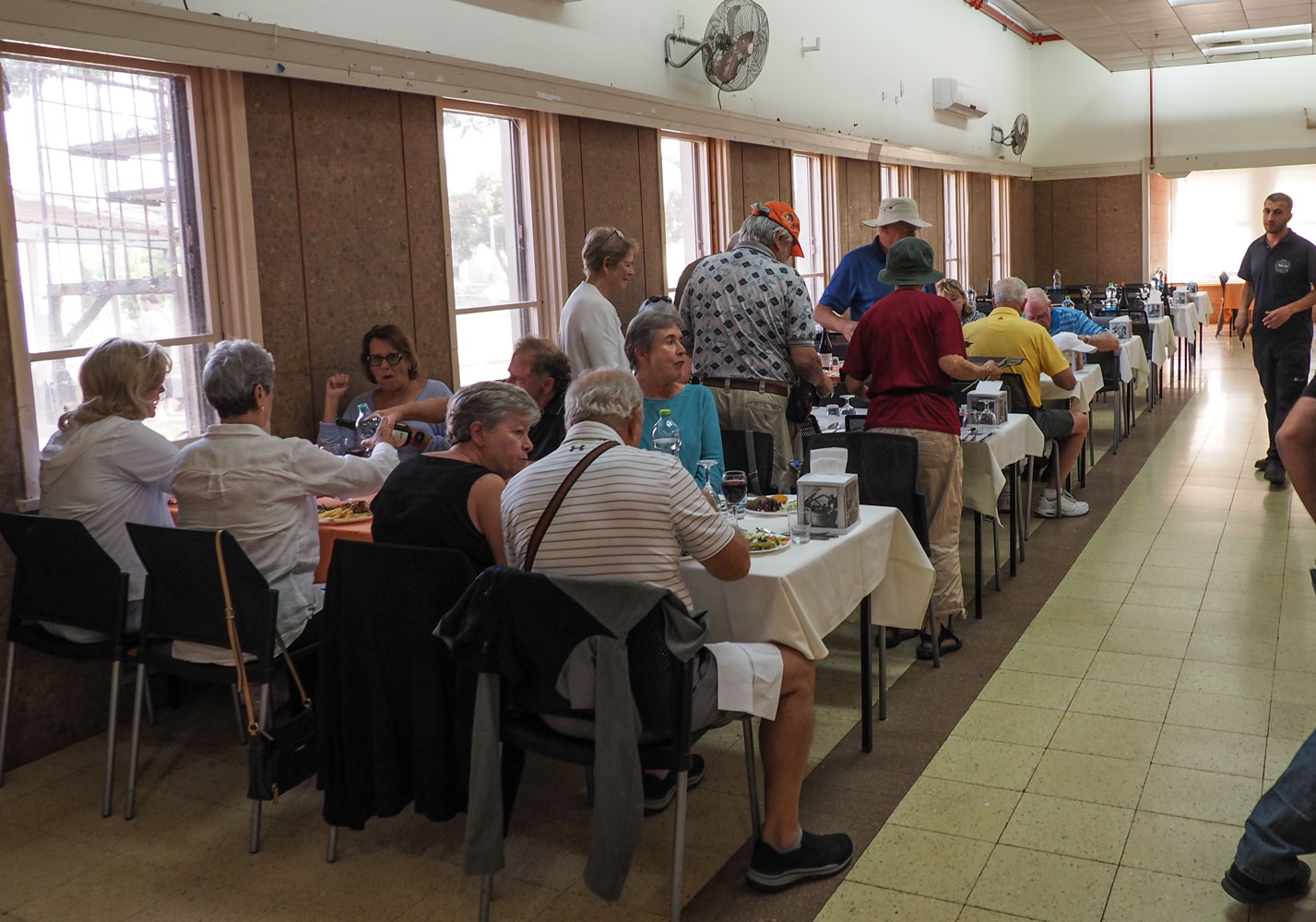
A larger view of one wing of the dining hall. The students were in the other wing and the tourists were in this wing. The facility was very nice - maybe a bit institutional but not too much.
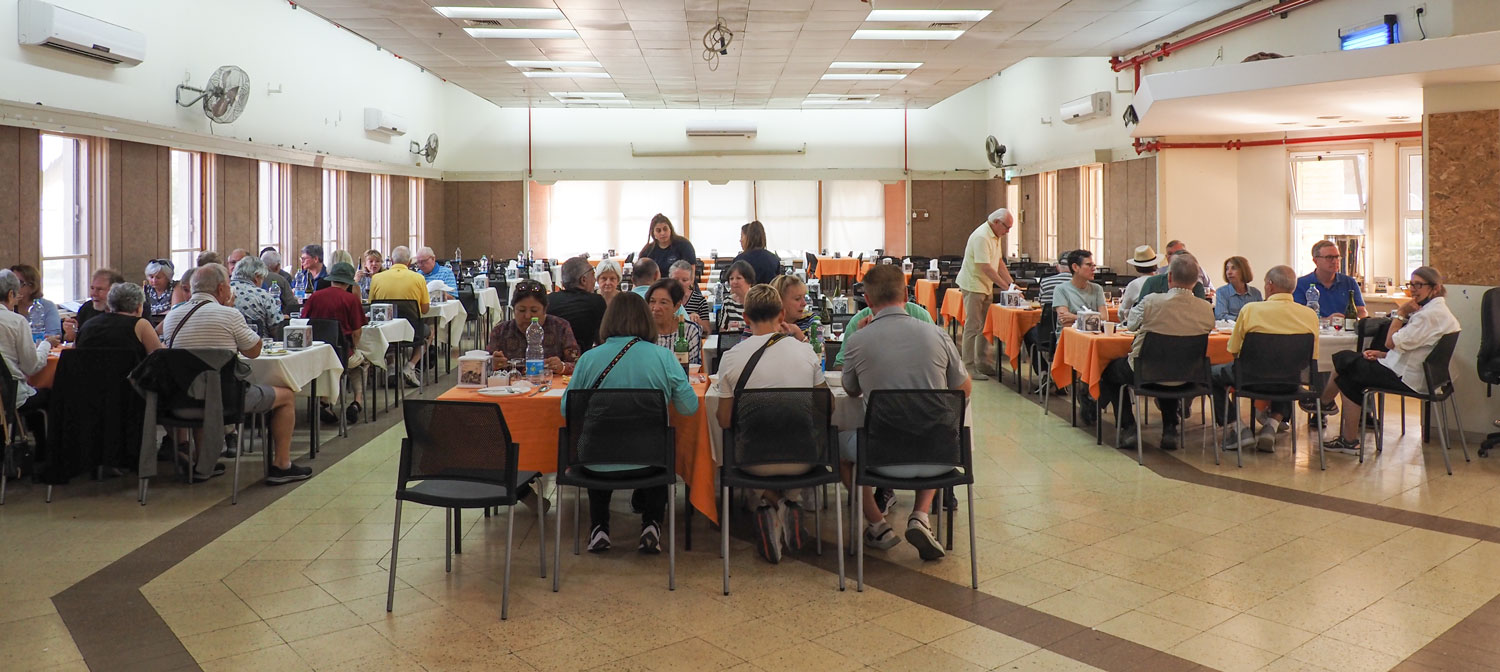
The food service was set up buffet style. The thing that amazed me was the number, variety and quality of offerings. I took pictures of the various buffet stands but I won't bore you with all of them. Here's one that was mostly salad (if I remember correctly). There were two stands like this, and the offerings were different.
There were four stands of meat, fish and vegetables - there were duplicates on some of them.
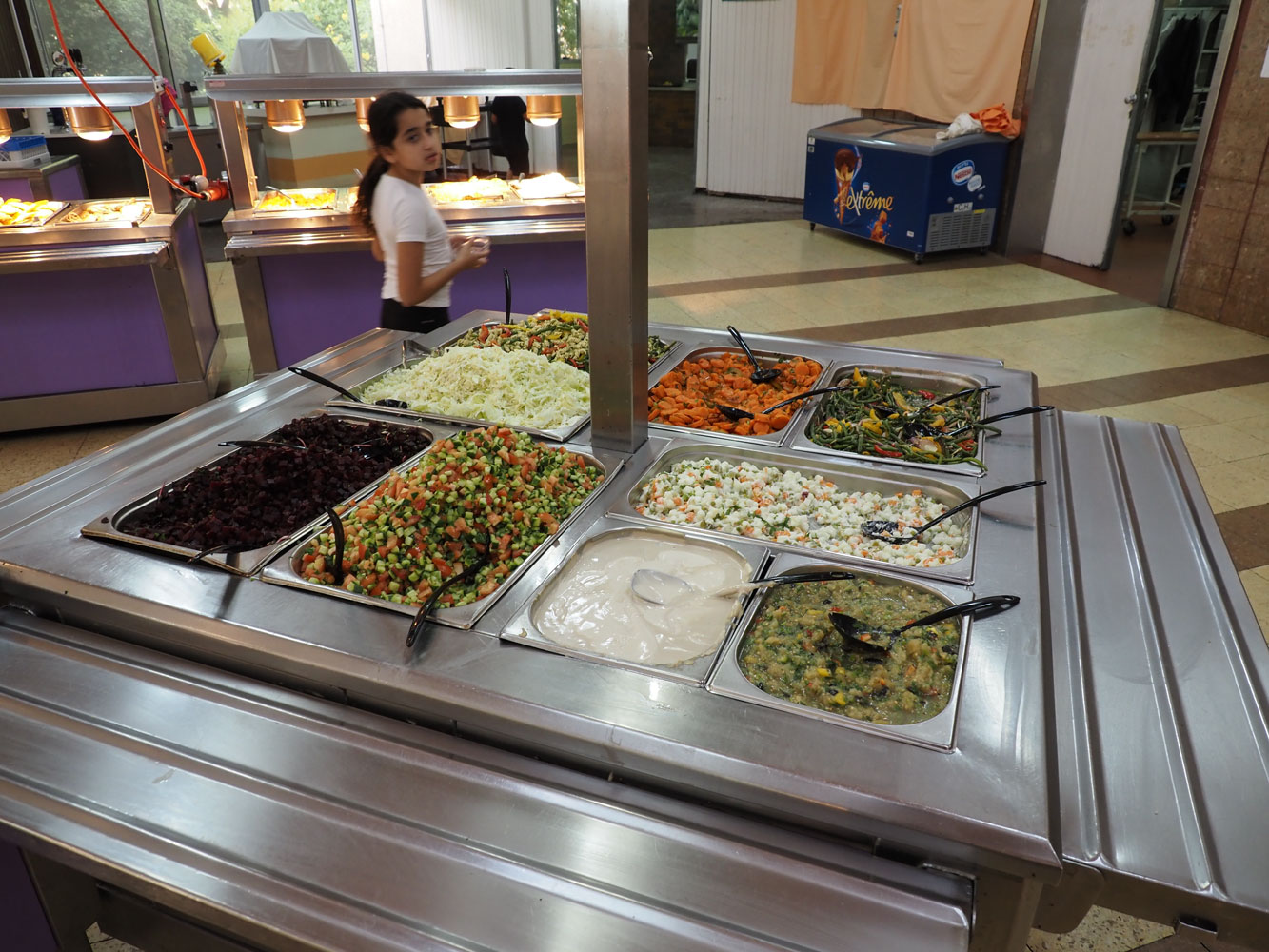
The food was very good. I don't remember cafeteria food like this when I was a kid, especially the variety. There were many students in the dining hall while we were there, and they took what they wanted.
One thing I especially noticed was that there was no dessert station for the students, although I see what looks like an ice cream freezer in the background of the above picture.
All-in-all, I thought it was a wonderful lunch, not just the food (which was very good) but for the ability to see a school dining hall - a bit of the students' life.
After lunch we went to Yardenit, which in the Christian tradition is the place where John baptized Jesus. It's impossible to know the actual site, but in 1981 Israel established Yardenit as a baptismal site for Christians. I suppose what's important is that the site represents something described in the bible, even if the actual location is unknown.
The New Testament was not "canonized" until the councils at the end of the fourth century. Prior to that, multiple versions of the stories existed as Christians modified and shaped the stories to appeal to the people they were trying to convert. The Old Testament has similar problems - Example: Moses' parting the Red Sea, which is 190 miles wide and 7,200 feet deep. Certainly an exaggeration of something much simpler.
Yardenit was established south of the Jordan River outlet from the Sea of Galilee. It is owned and operated by Kibbutz Kvutzat Kinneret.
Here's the entrance.
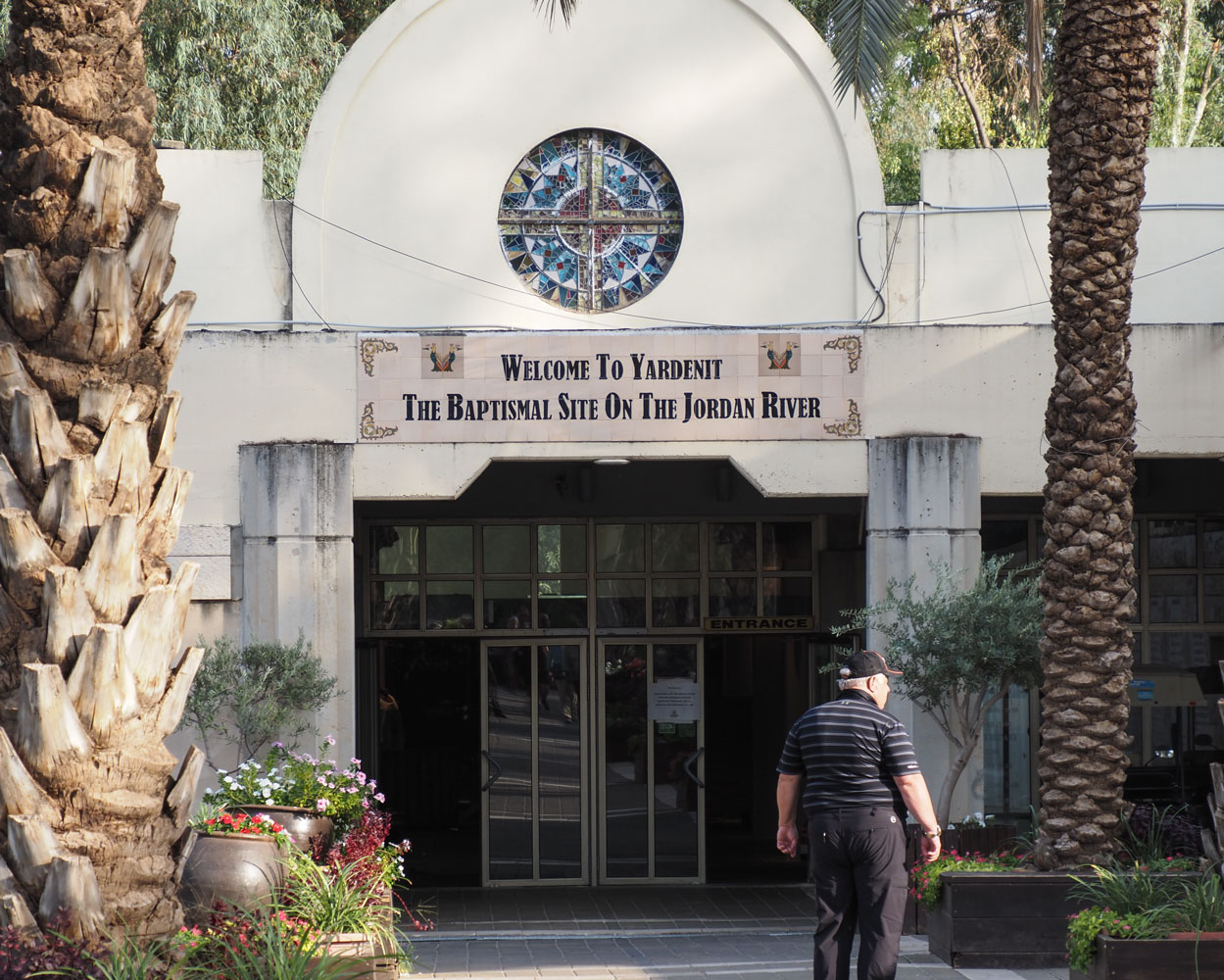
And here's a view of the Jordan River, looking south, away from Yardenit.
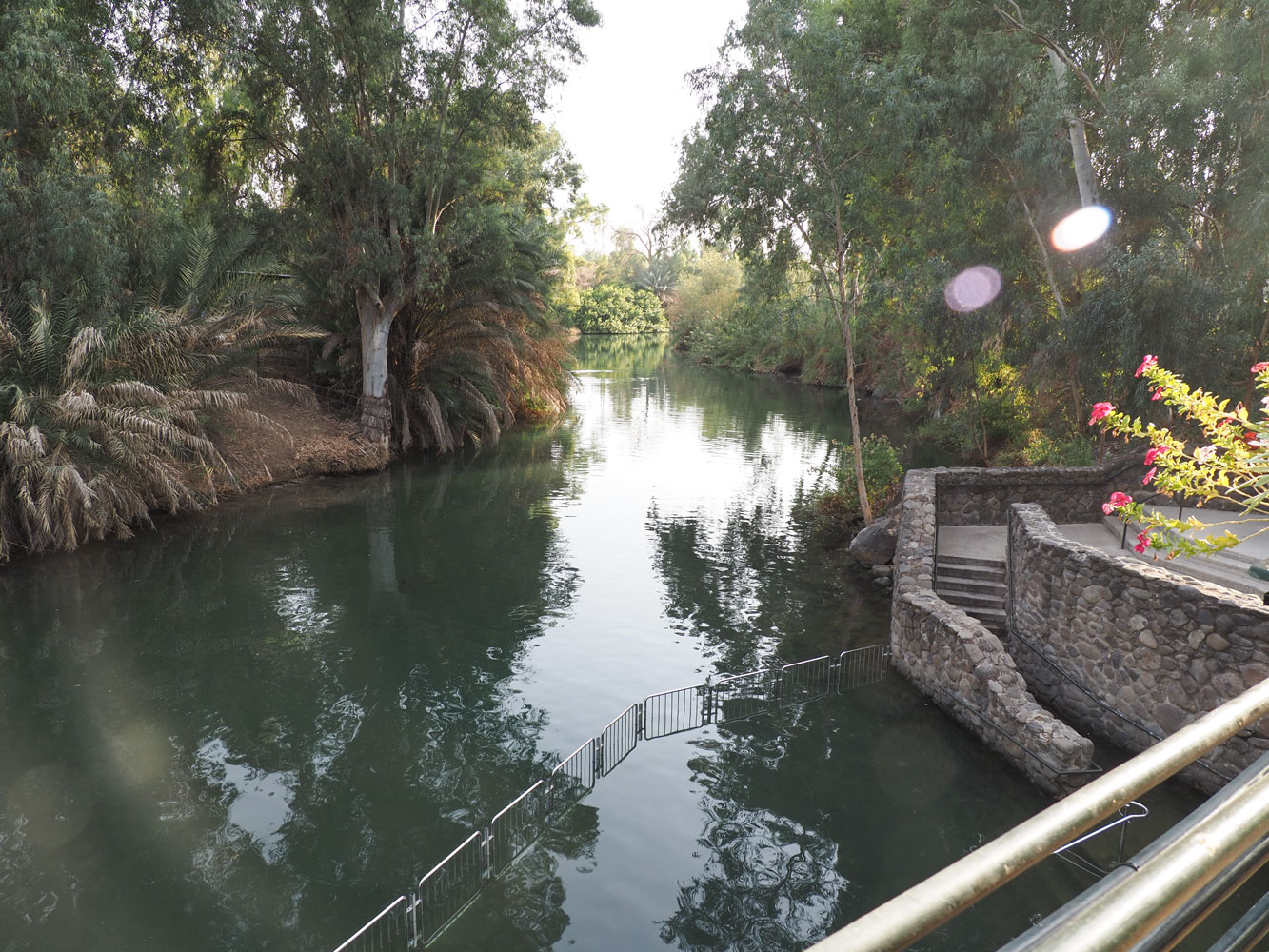
There were three fenced-off areas where people could go into the river. I think the pilgrims could rent the white pullovers, which included the fee to use the facility.
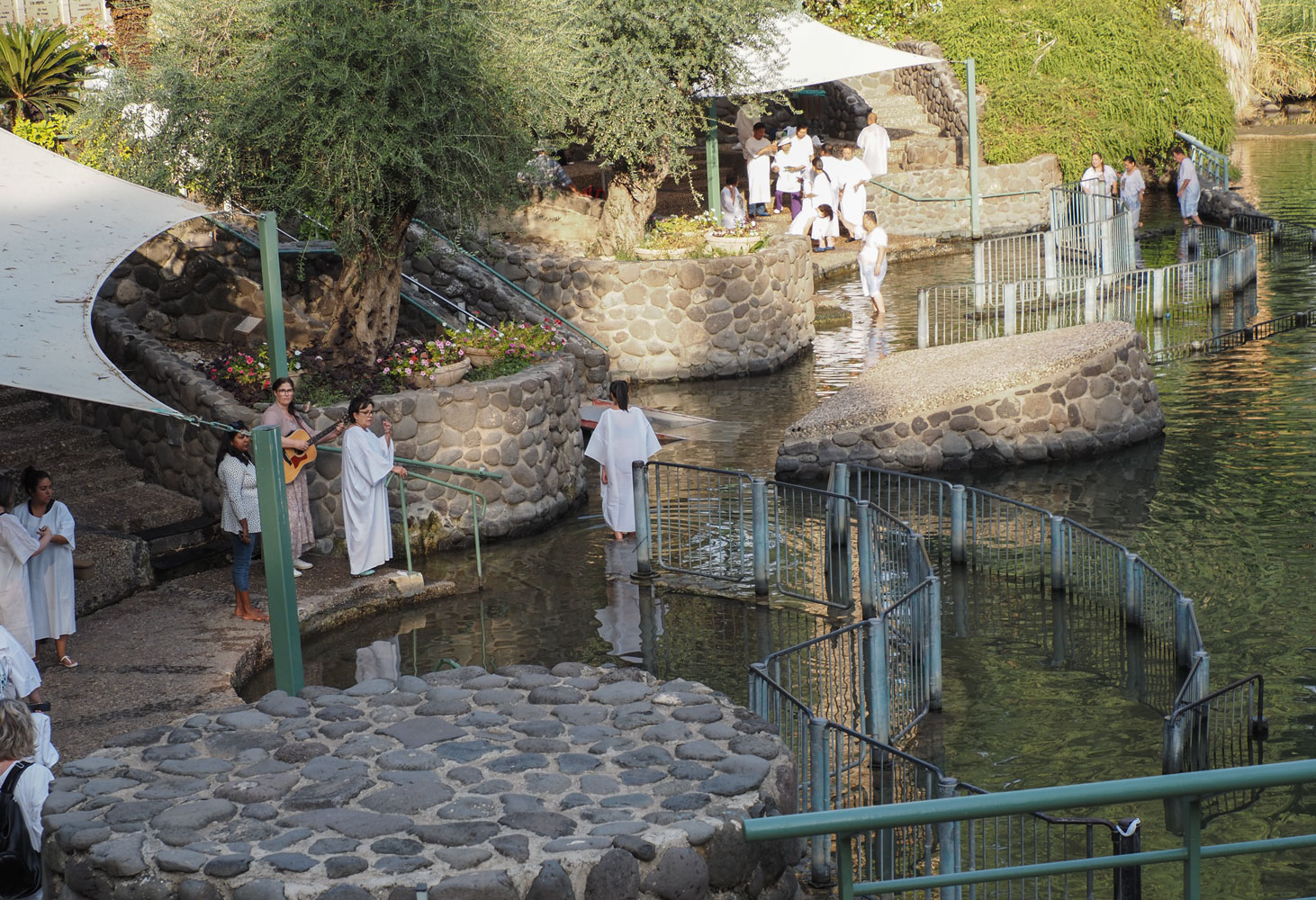
It looked like some people were being baptized, while others just wanted to wade in the river.
I know that some churches organize religious tours to visit many of the biblical sites in Israel. This may be one of those groups. They were obviously a group and were singing hymns when I took this picture. I didn't see any of them baptized so I expect they just wanted to experience the Jordan River.
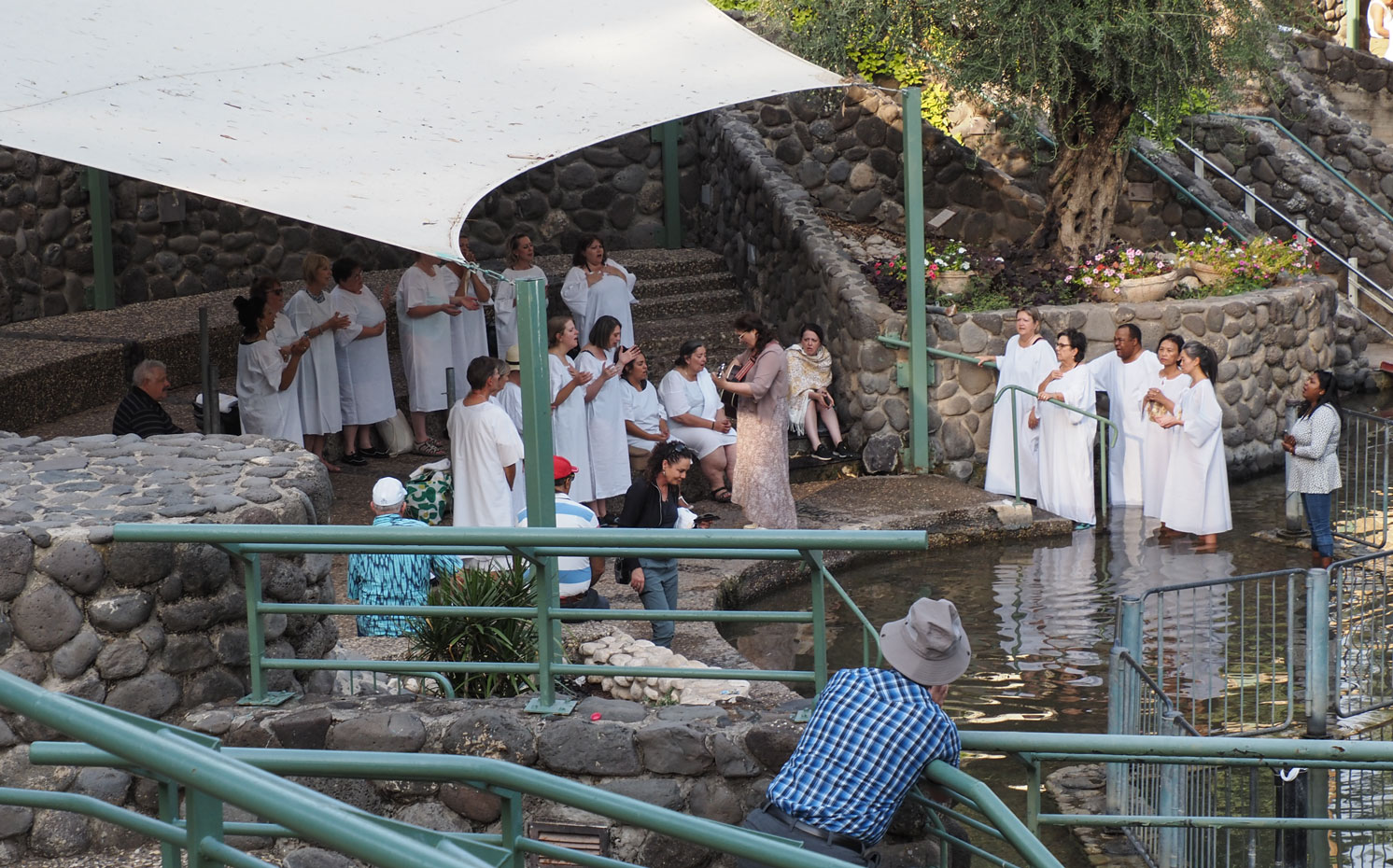
I photographed a full-immersion baptism. Here's a woman getting ready to be immersed. She's holding her nose.
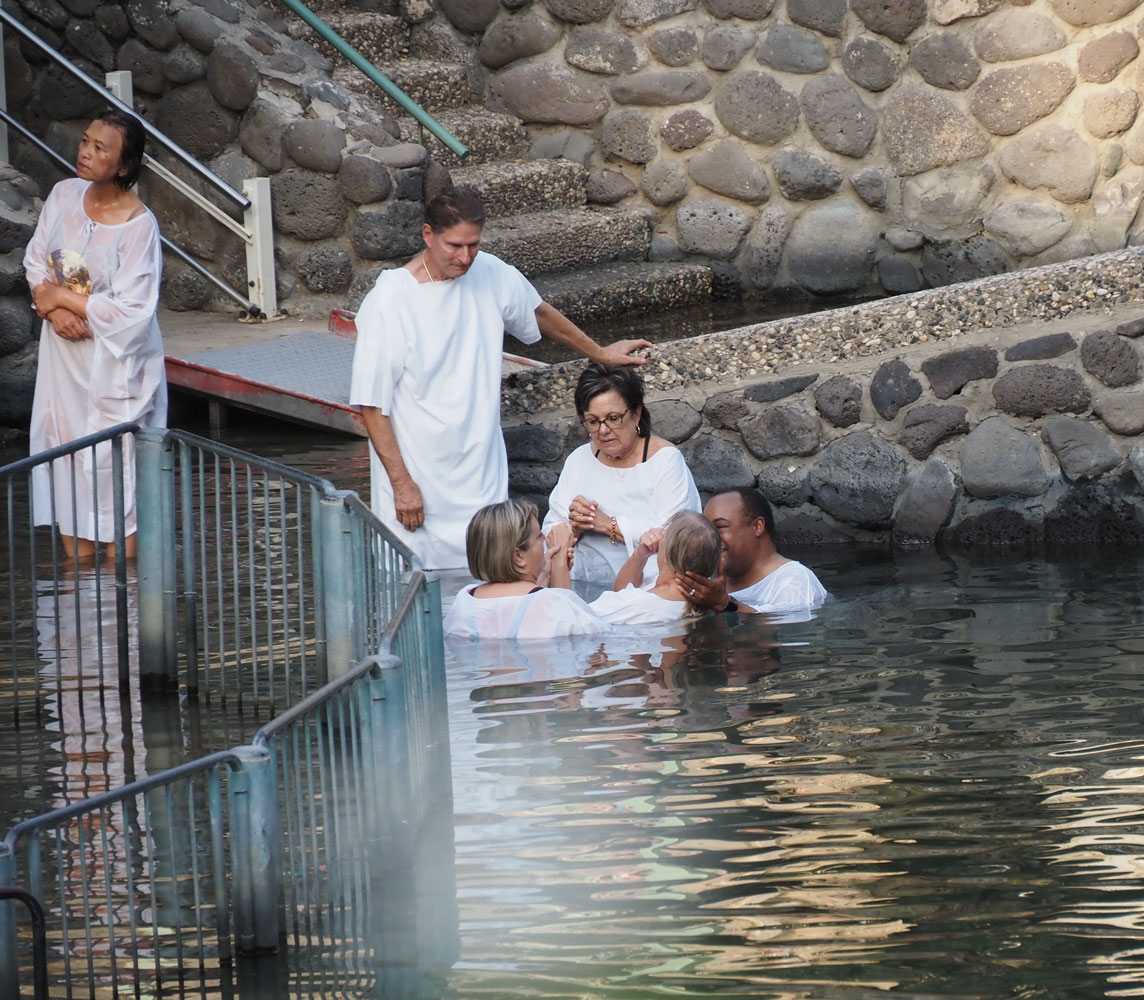
Going down.
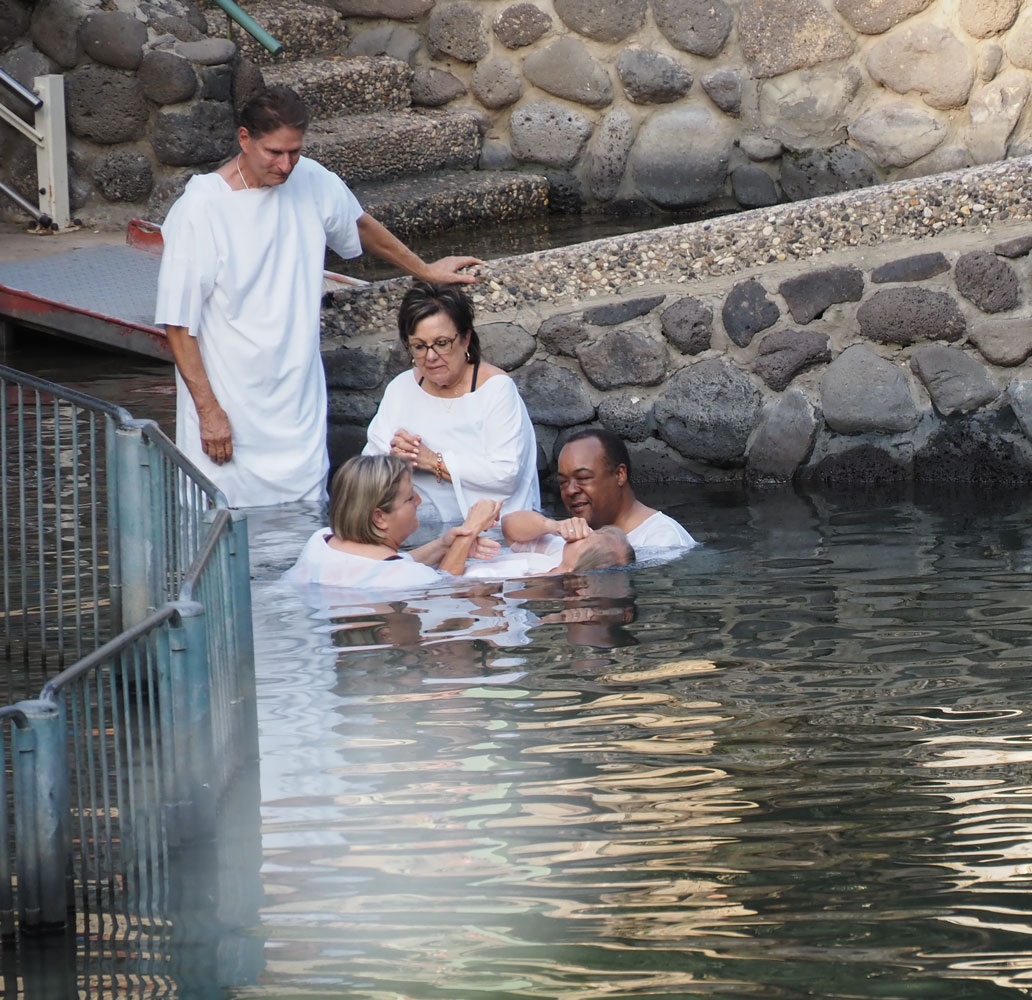
Fully immersed.

And back up.

That was the end of our tour. We boarded the bus for our long ride back to the ship. I began to feel a scratchiness in my throat while on the bus, and it developed into a cold after I got back to the ship.
We arrived at the ship after dark.
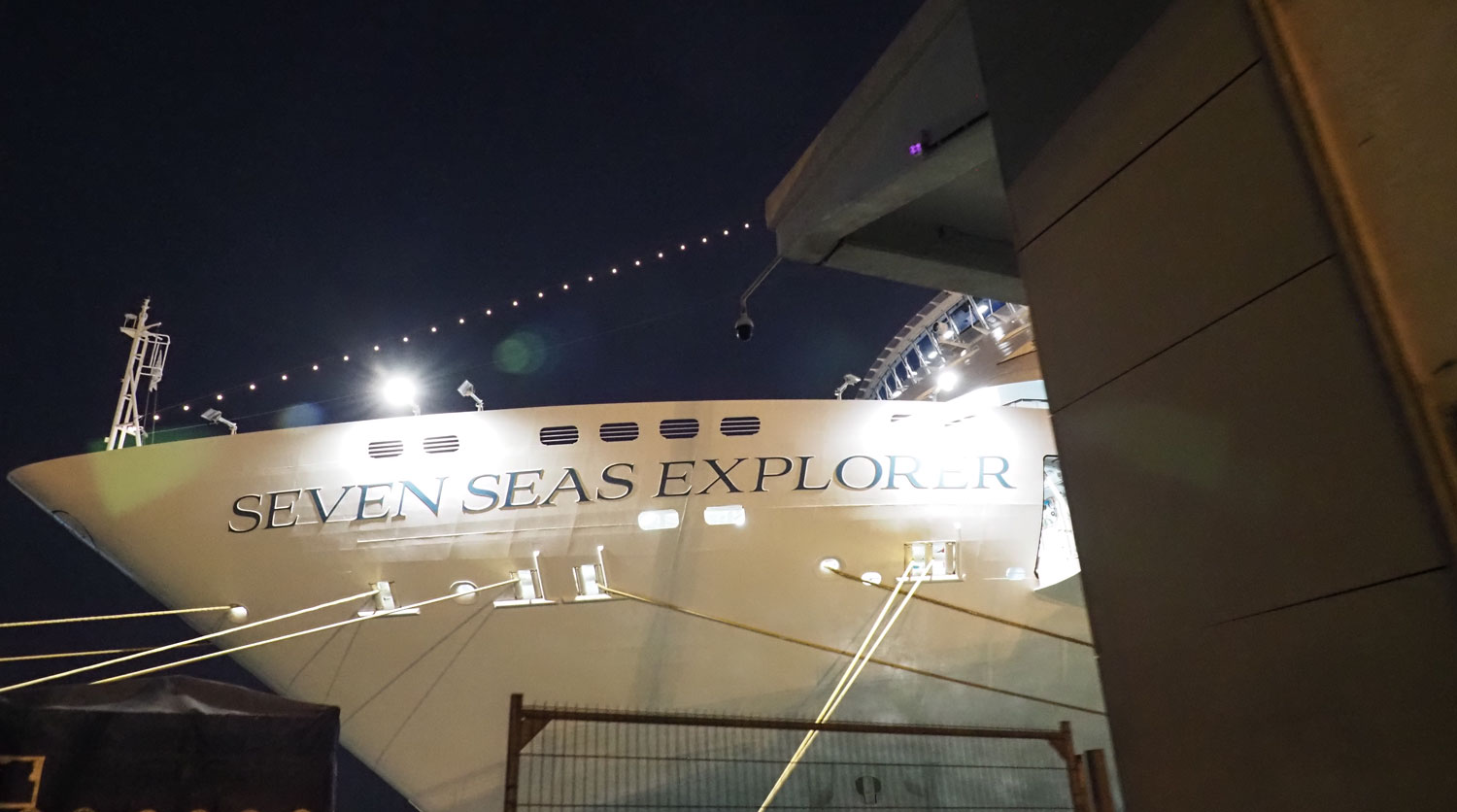
It was not a great excursion - the bus rides were very long, the tour director got lost, and we did not go up on the Golan Heights, even though that was advertised as part of the tour. I had wanted to see the Golan because that's where Israeli army made a heroic stand against overwhelming odds in the Yom Kippur war. The Israeli 188th Tank Brigade was almost wiped out - 90 percent of their officers were casualties - but the brigade continued to fight.
If you have any interest in military history, I recommend reading the stories I included as links. The Syrians attacked with 1,200 tanks. Against them, the Israelis had 170 tanks.
+++++++++++++++++++++++++++++++++++++++++++++
11/7/2022 (Monday) We take a tour of Jerusalem today. Judy and I had been to Jerusalem in 2017 when we took a Tauck land tour of Israel. We stayed in a hotel in Jerusalem on that tour and had lots of time in the city. I had been to Jerusalem prior to that, in 2000, when I had a business trip to Israel.
When I went in 2000, the guide took us to the Mount of Olives before taking us into the Old City. Here's the view you get from the Mount of Olives. That's the golden Dome of the Rock on Temple Mount in the center of the picture. I found this picture on the web - it's not mine.

Our tour guide was a retired police officer, Amiad Vinkler.

Our first stop was at the Old City
We entered through the Dung Gate, which gives access to the plaza of the Western Wall.

When I came to Jerusalem in 2000, the guide took me through the Zion Gate, which was interesting for a couple of reasons. First, there was intense fighting at the Zion Gate during the Six Day War, and they've left the pock marks from bullets at the gate. Second, you have to walk through some of the Jewish Quarter to get to the Wailing Wall plaza. Here's a picture of the Zion Gate taken from the web.

Just for interest, here's a link to a description of the seven open gates of the Old City (the Golden gate is walled up). And here's a map showing the gates and the different Quarters.

I suspect the residents of the Jewish Quarter got tired of all the tourists coming through their quarter from the Zion Gate so the guides moved to the Dung Gate.
We had to clear security to enter the plaza.
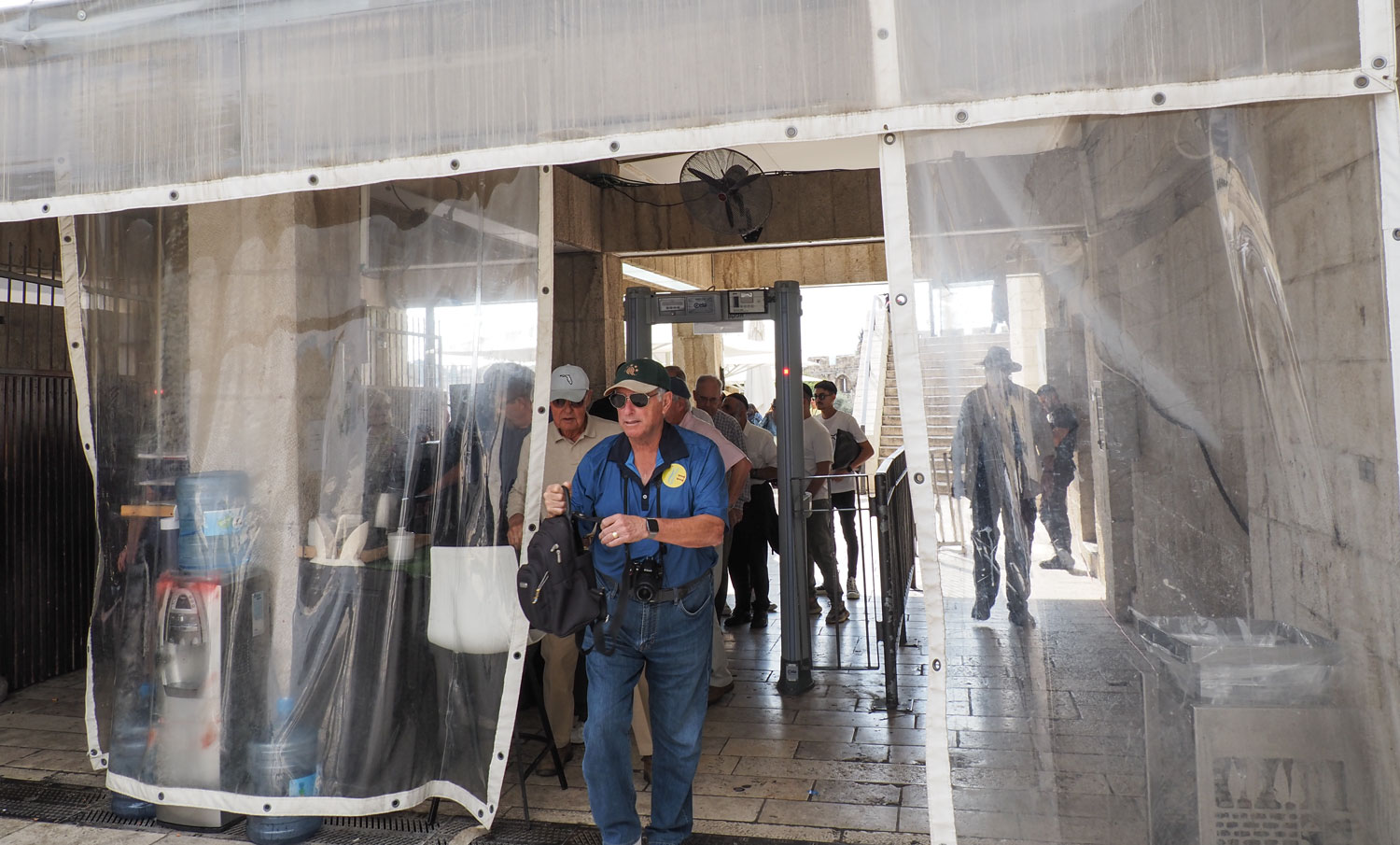
A view of the Western Wall. To the right in the picture is the ramp to the Temple Mount.
I had gone to the Western Wall on my two previous visits and didn't go this time. Judy and I had visited the Temple Mount in 2017 and it was interesting to see the area. A visit to the mount was not offered on this tour.
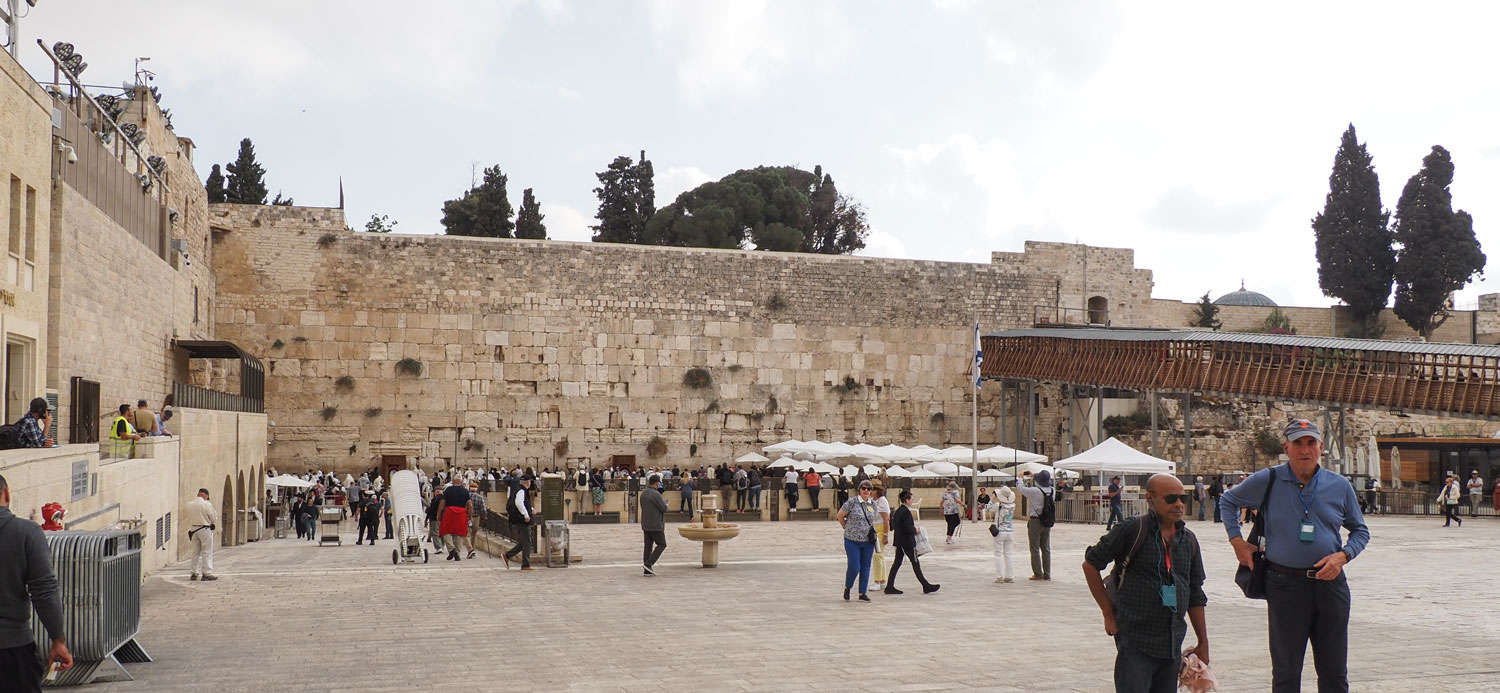
We left the Wailing Wall area and walked through some of the narrow streets of the Old City, toward the Via Dolarosa, the path, in Christian tradition, that Jesus took to the site of his crucifixion.

This was a side "street" of shops. I noticed that many shops in the Old City carried the same merchandise, especially those selling souvenirs. I suppose with the huge number of tourists, each one can sell enough to stay in business.
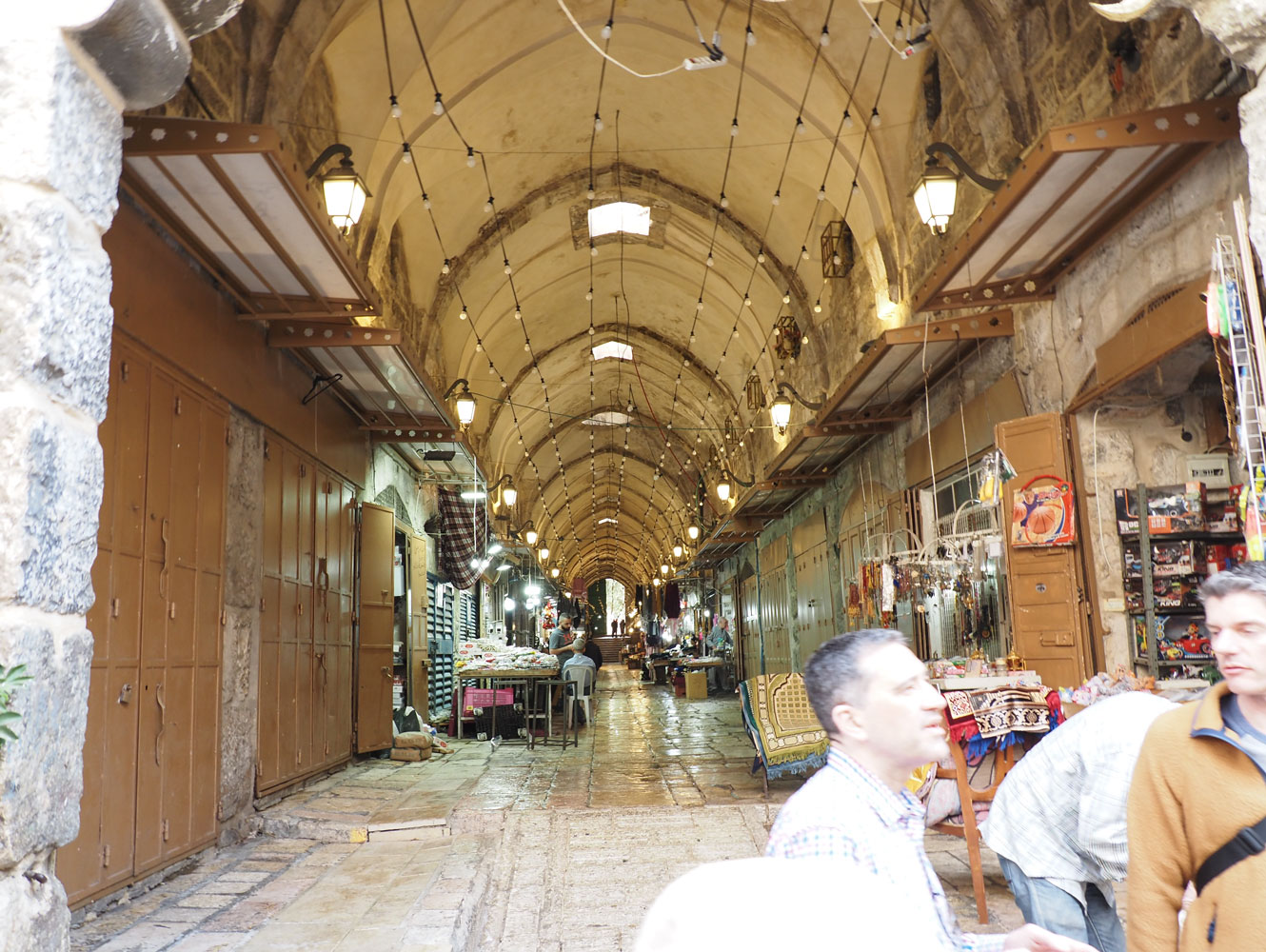
A more typical street/shopping area.
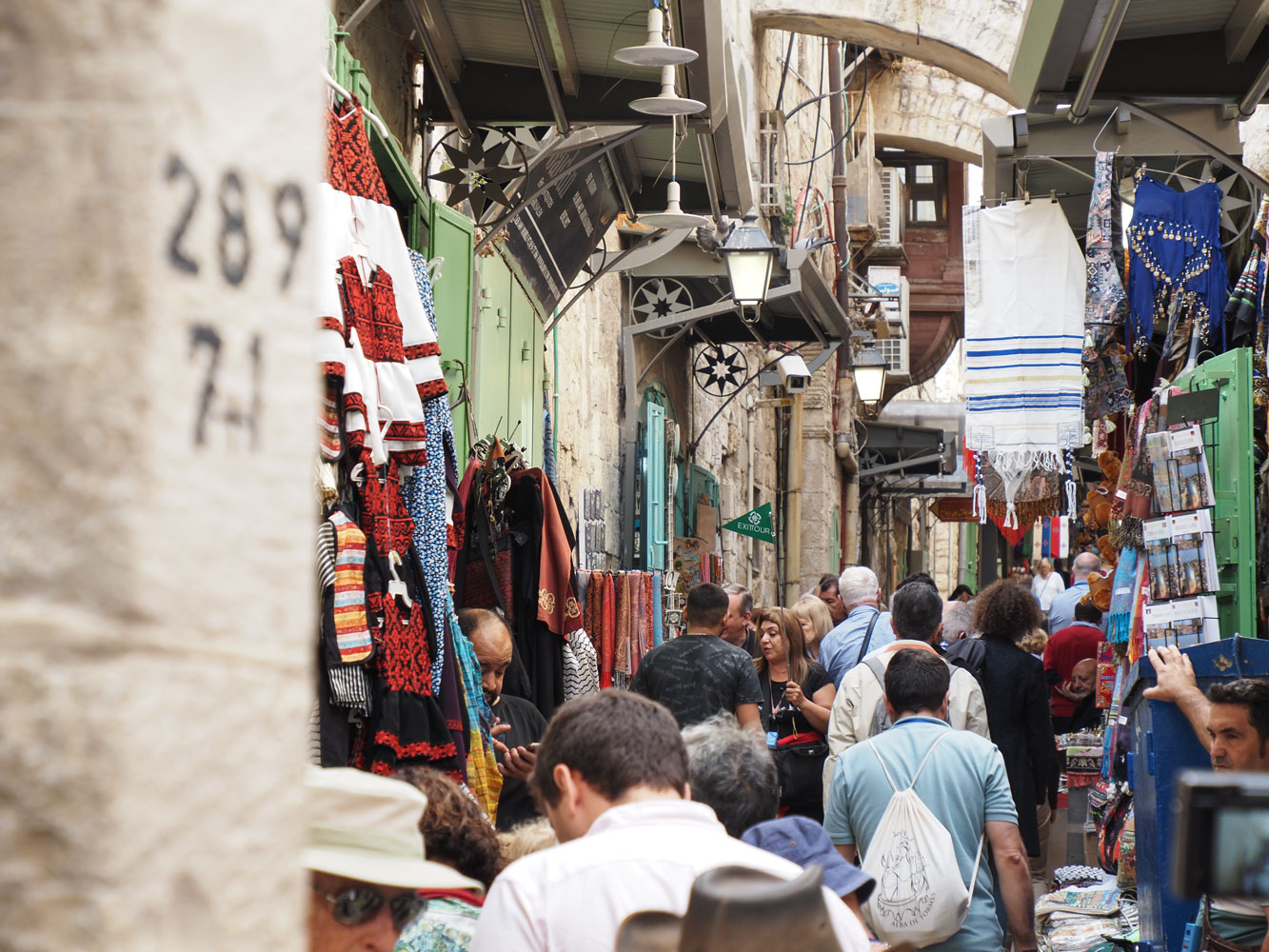
We eventually came to the location of the fifth Station of the Cross. There are 14 stations. In Catholic churches, there are pictures along the sides of the church, usually seven on each side, and during a certain time of the year (especially Good Friday) the priest will lead followers to each in turn, stopping to pray at each one.
The stations are marked by the black, shield-like marker with the station number in Roman numerals.
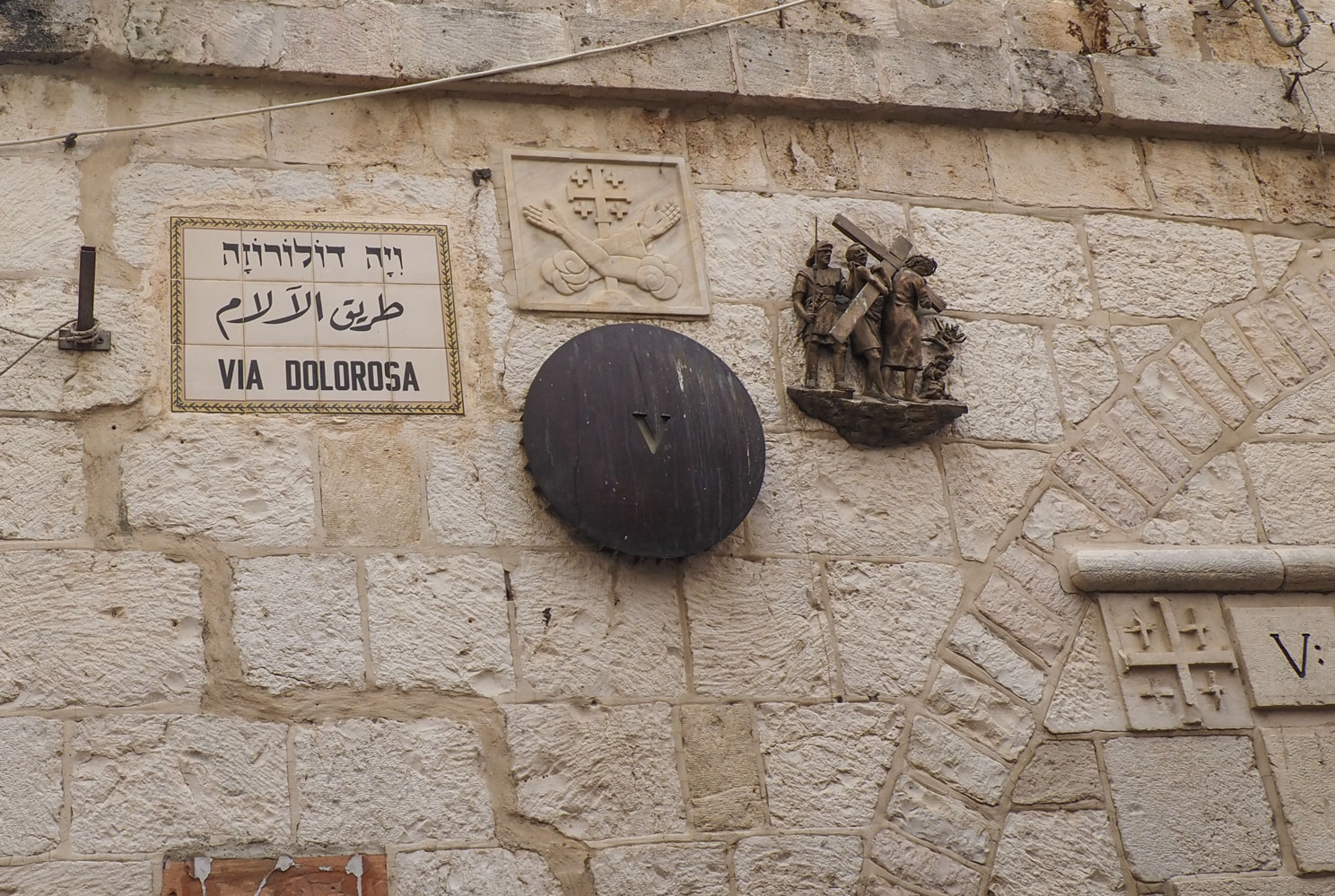
At seven there was a grotto. This is what you'd see immediately upon entering.
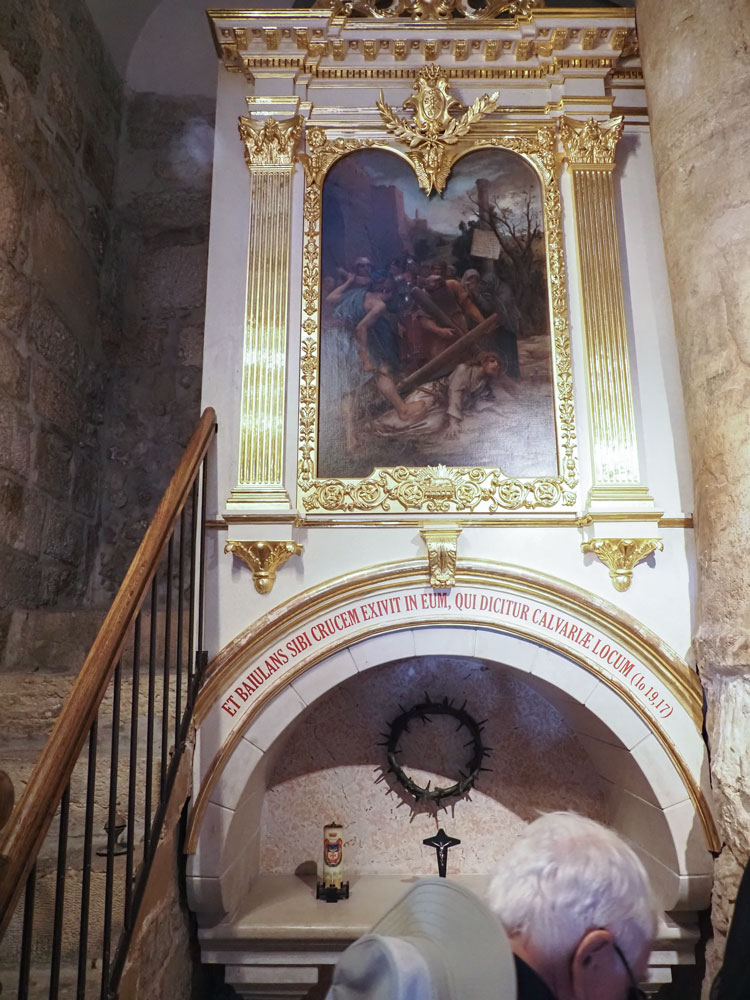
Further into the grotto was an altar.
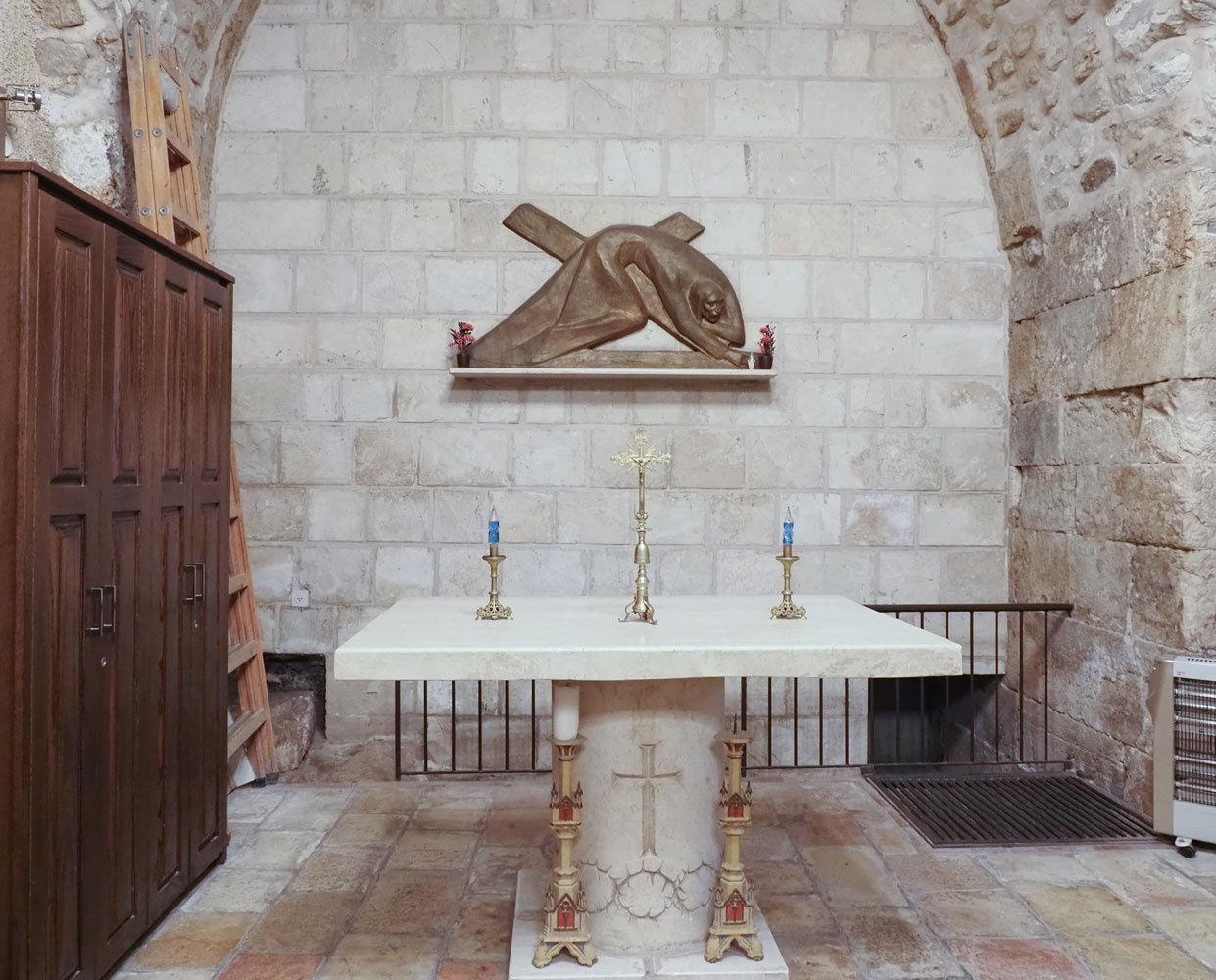
The guide then took us to the square in the Muristan area of the old city. There was a store there that had restrooms.
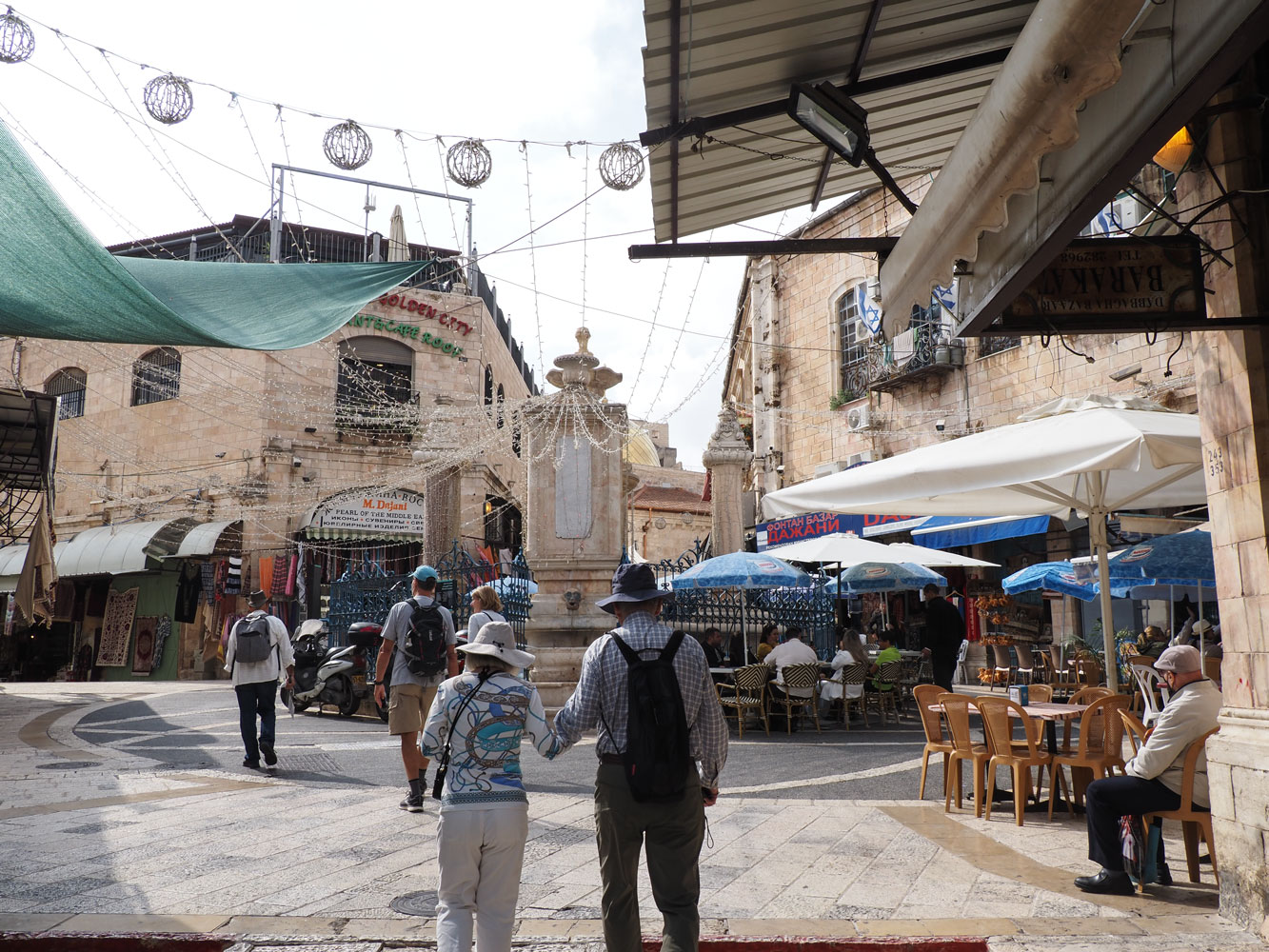
Here's the entrance to the store.
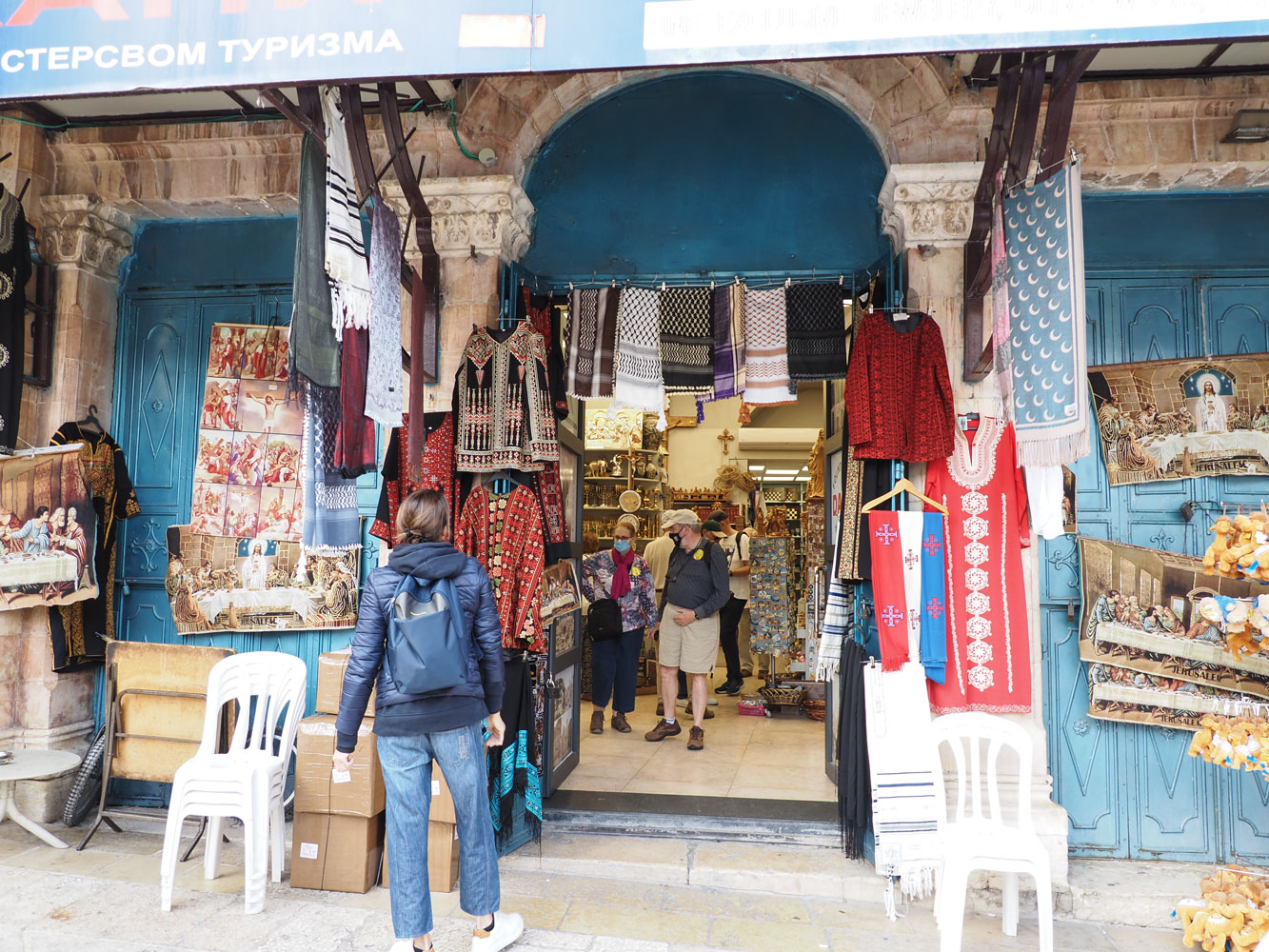
There were two independent sellers working the square, selling keffiyehs and a few other things. I don't think anyone bought anything. I have two keffiyehs from previous trips and, of course, never use them.
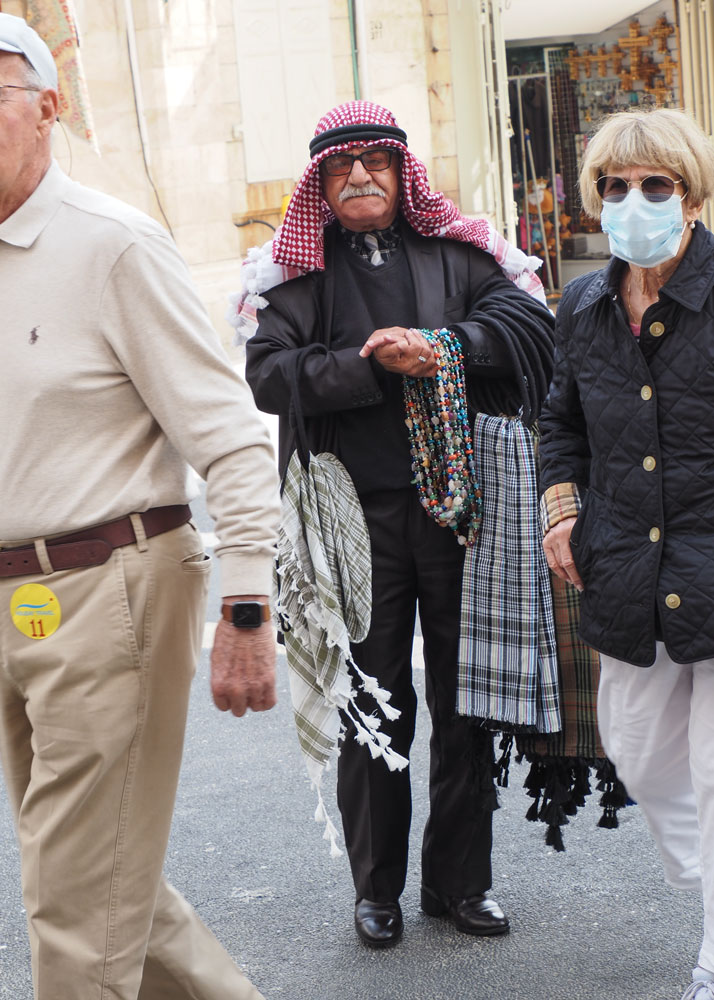
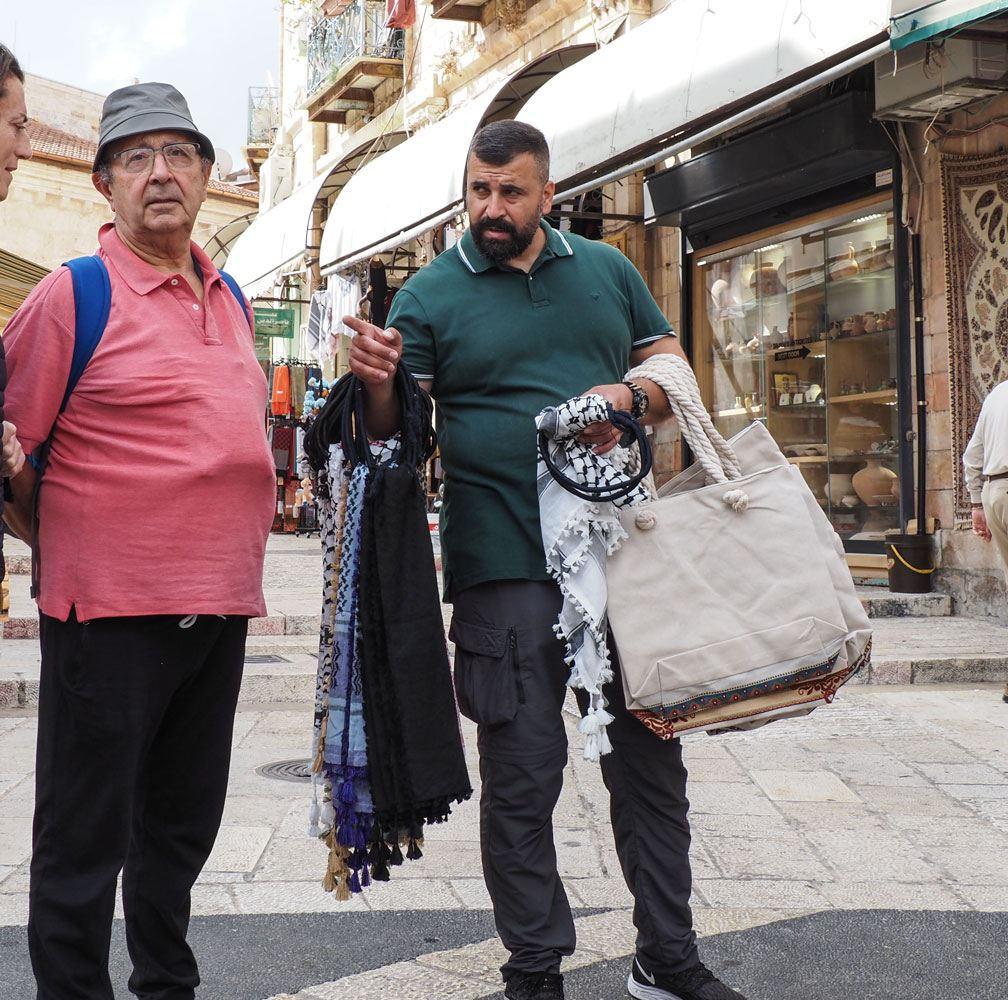
From here we went to the Church of the Holy Sepulcher. When we arrived there, there was a tent structure in the courtyard which made it impossible to get a picture of the front of the church - but I found one on the web.

It was about 300 years after the death of Jesus that someone began looking for the site where he died. Given that amount of time, this site should be viewed as representative of the crucifixion.
We entered the church and I went up the steep stairs located just to the left inside the entrance.
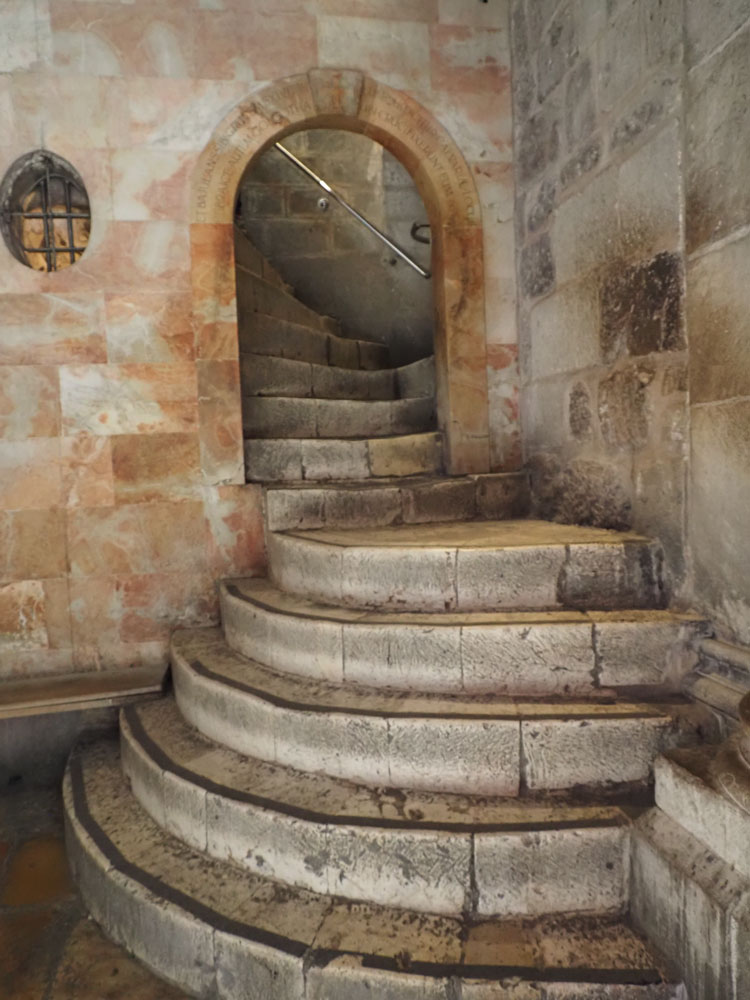
This leads to a second level reputed to be the location where the crucifixion occurred. The first thing you see is an altar and an image above the altar.
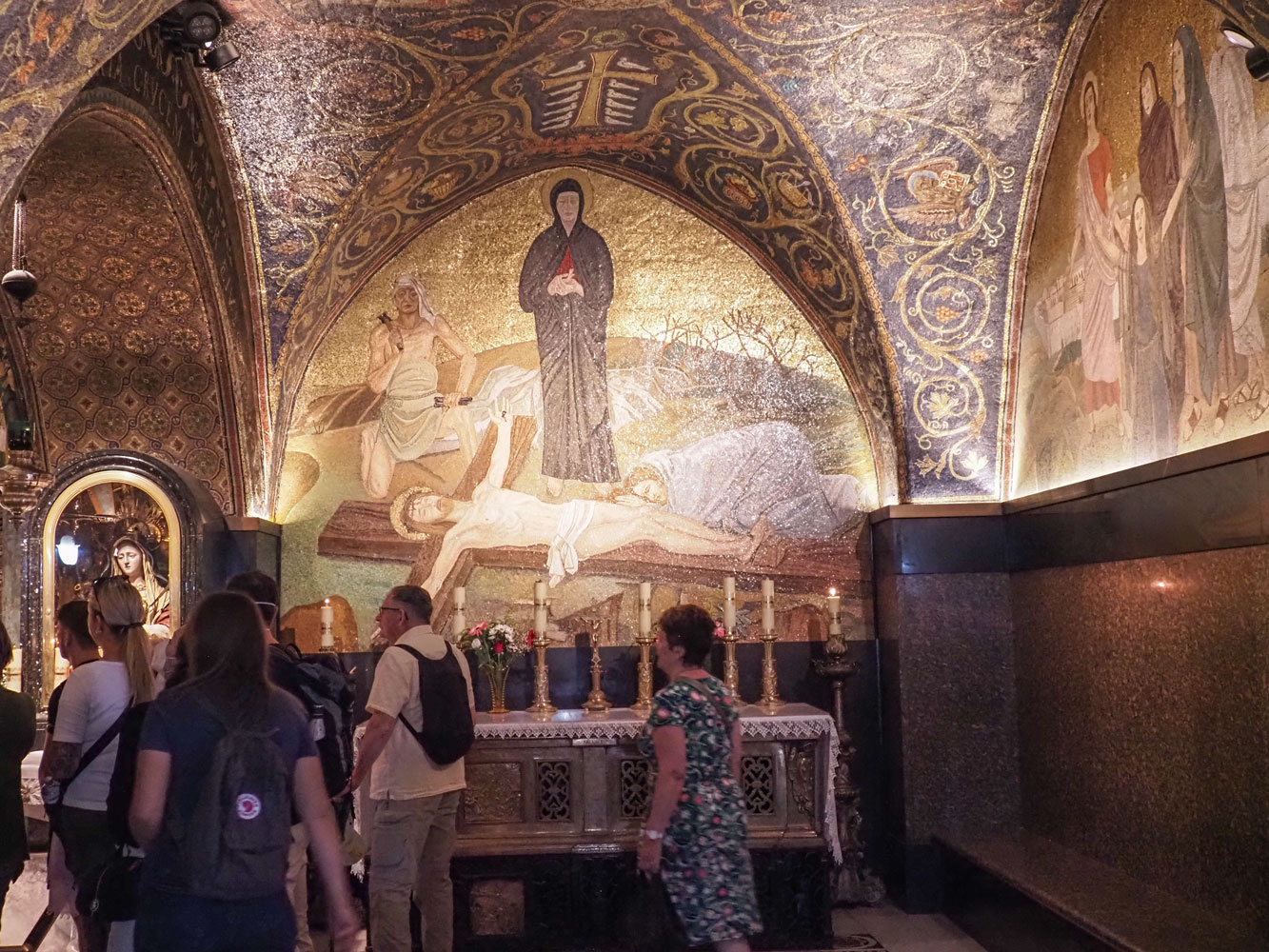
A bit further on there's a statue of Jesus on a cross, flanked by two angels. It was very difficult to get a good picture, especially with all the tourists.

Below the altar in this picture was a bronze plaque that represents the location of the cross during the crucifixion. The area was very dark and I was unable to get a picture but I did find this picture on the web.
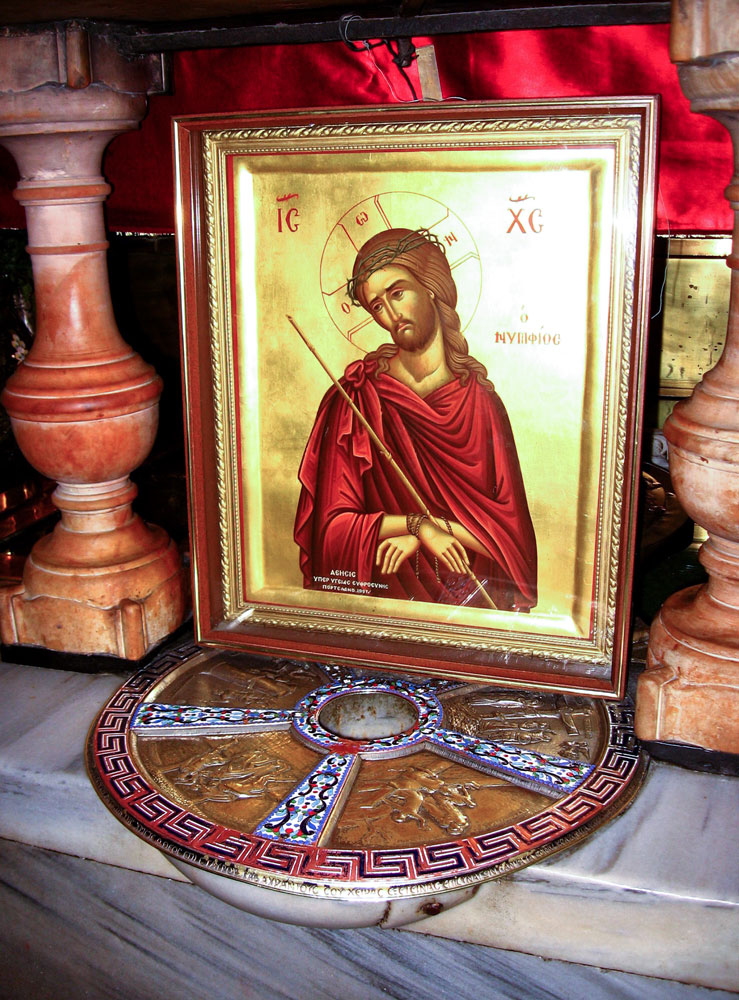
A view of some of the church from this second floor area.
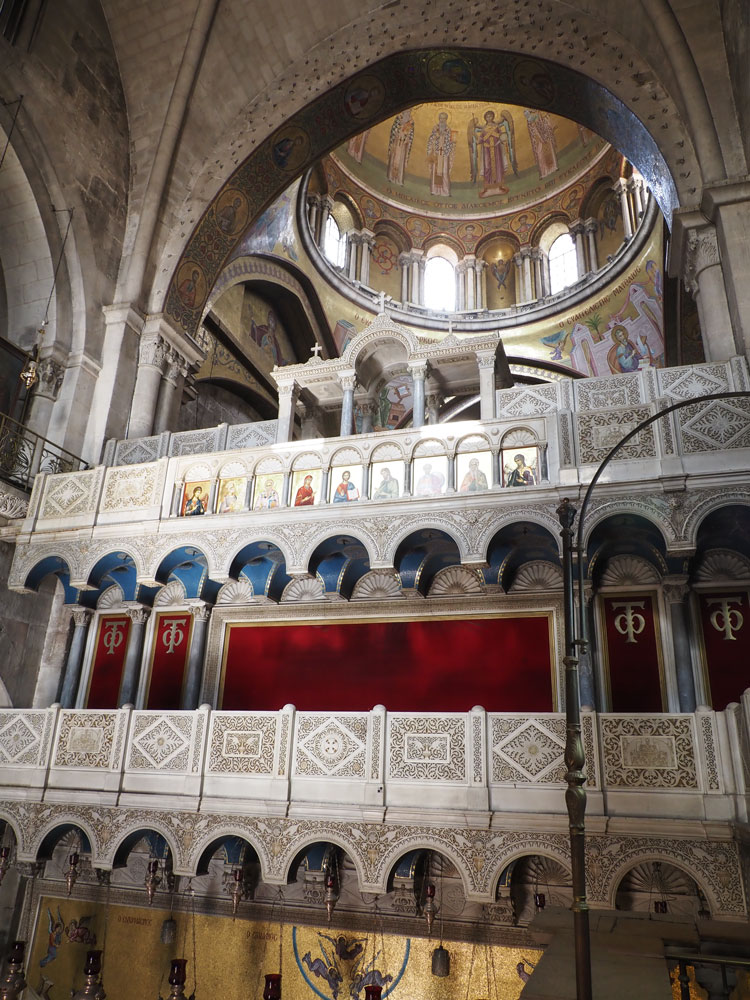
We exited the raised area by a separate steep stairs.
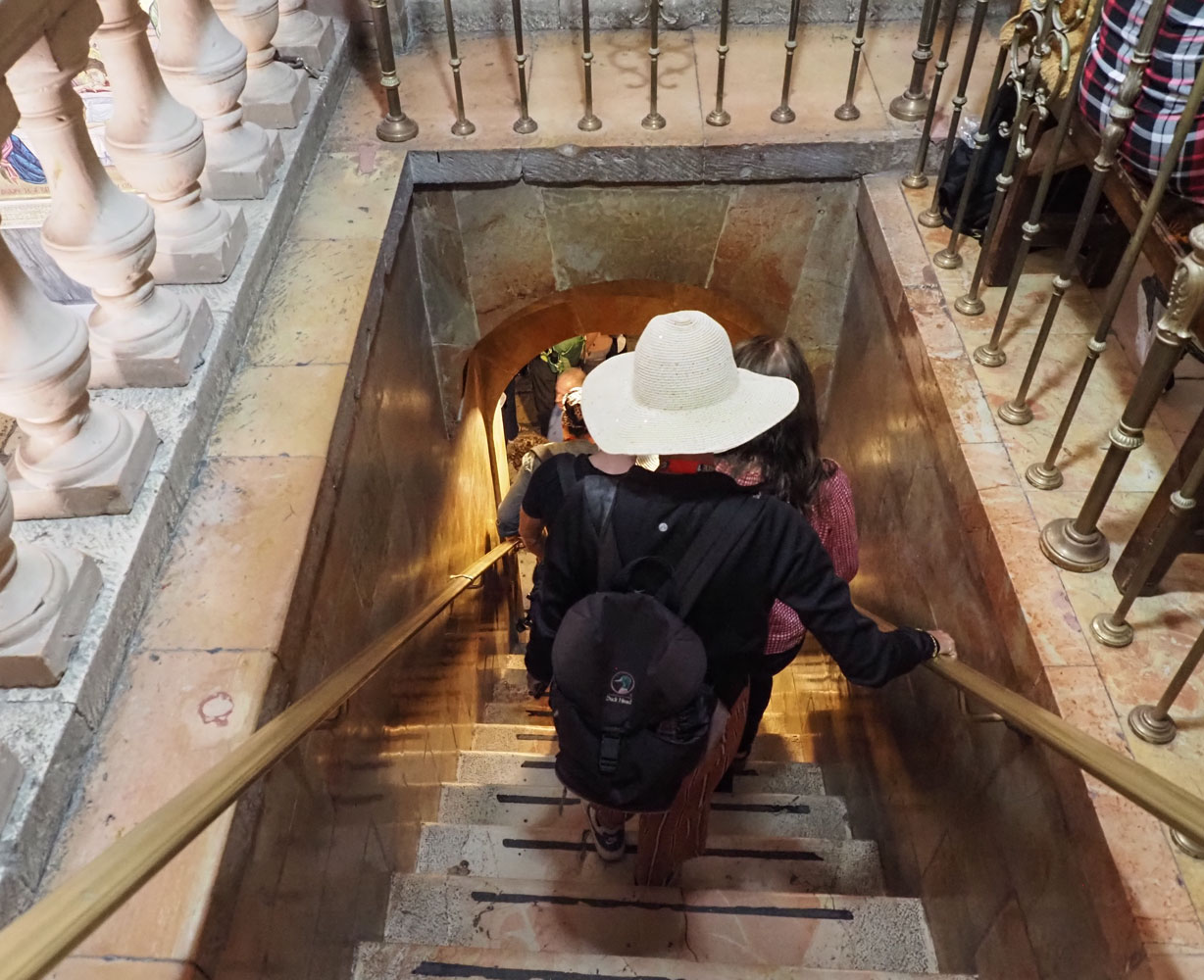
From the stairs, we went into the subterranean part of the church.

It was the Chapel of Saint Helena. There was an elaborate altar there.
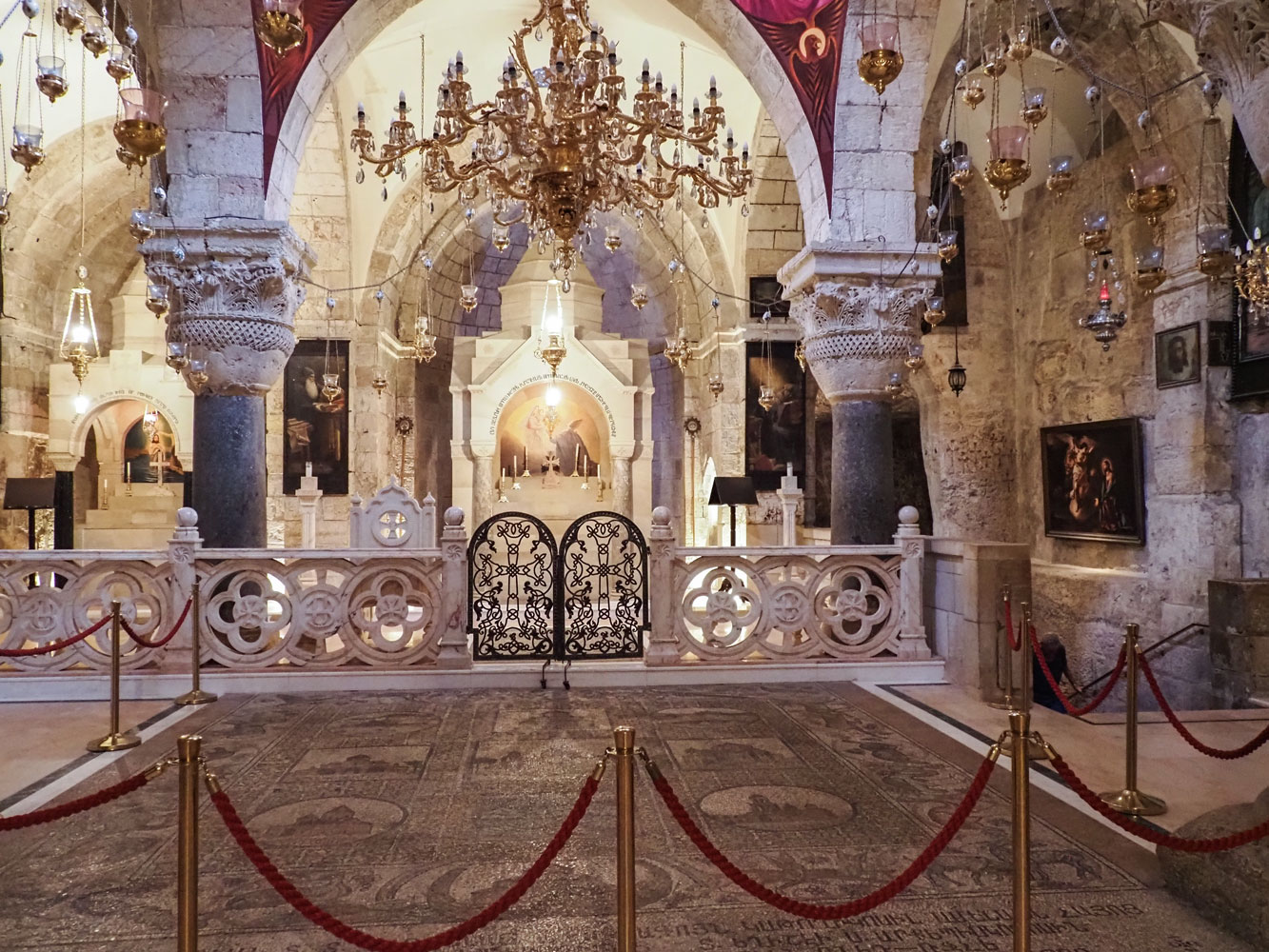
The mosaic in front of the altar area.

And the highly painted dome above the altar.
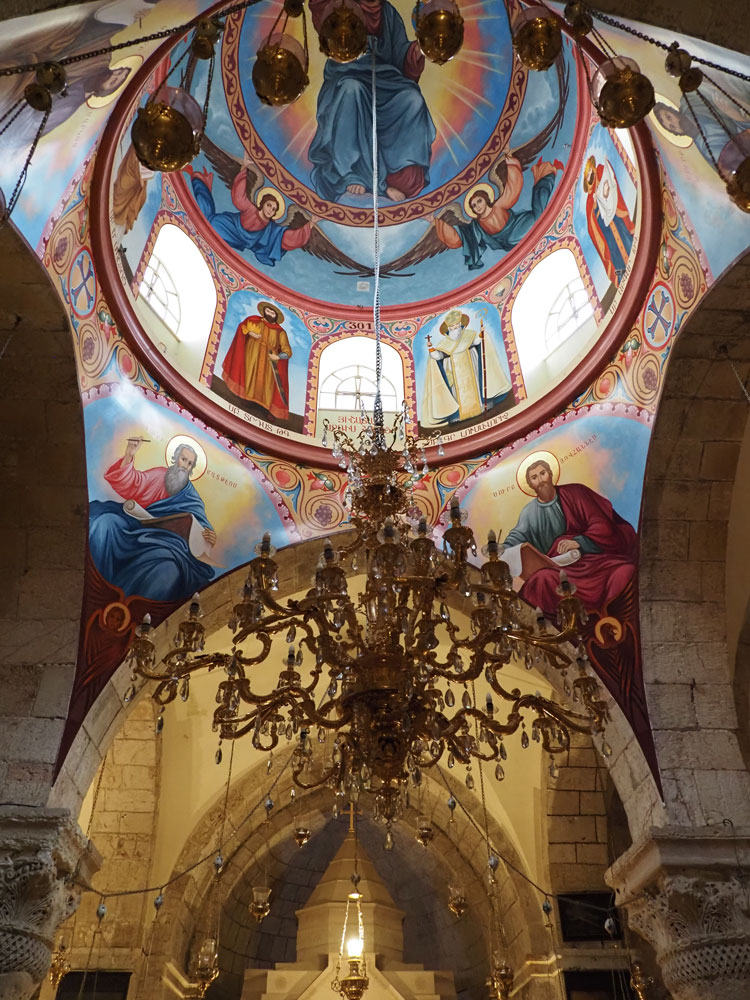
There was an area below this altar area and it contained a small chapel with this altar area.

Then we went back up and headed to the area of the church where the tomb that Jesus was placed in was located. On the way, we passed the Stone of Anointing where Jesus' body was reputed to have been laid while it was anointed with oils. At the time we passed, there were several clerics washing the stone.

Then we entered the area of the large dome, containing the Aedicule.
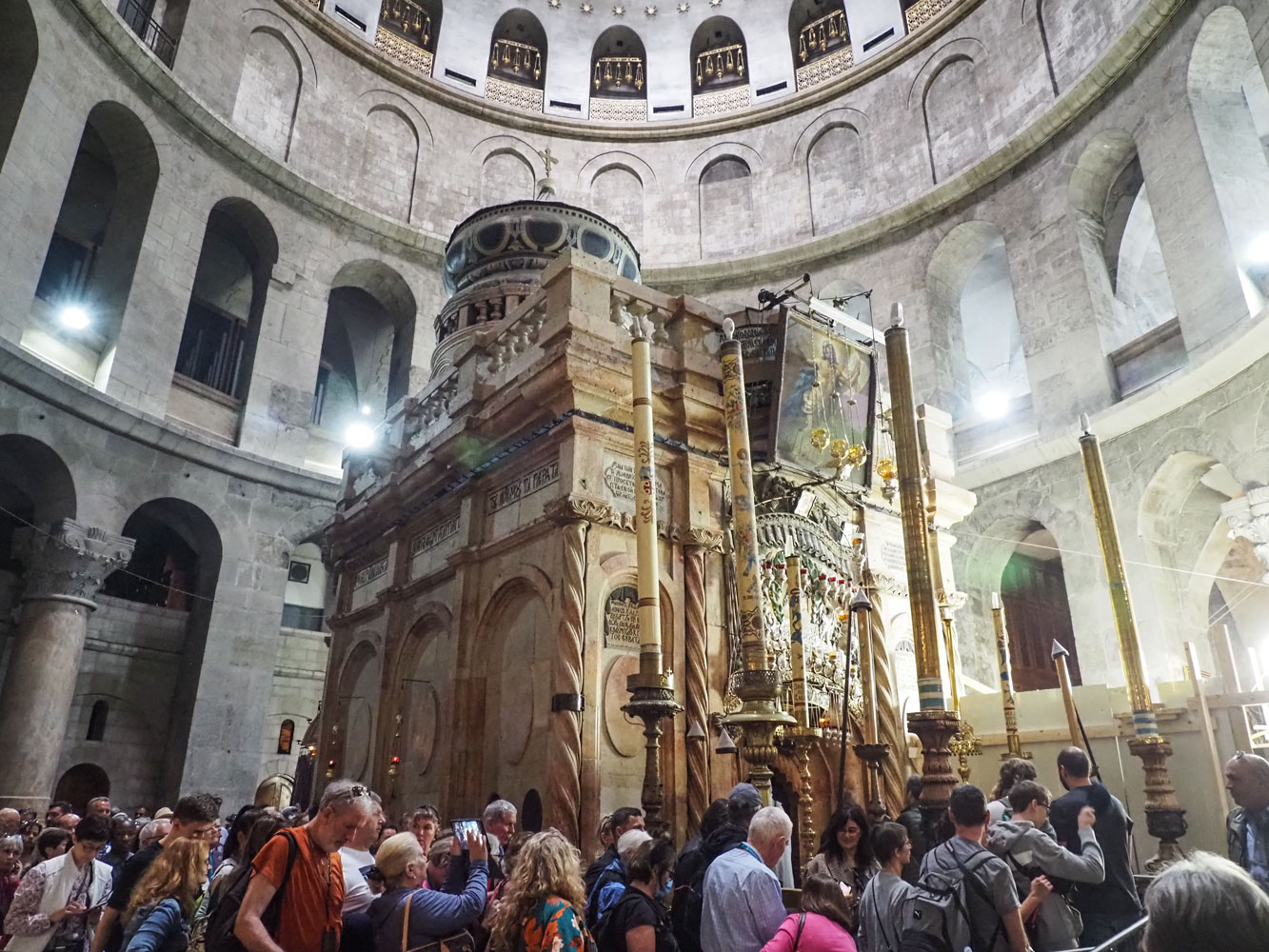
People are allowed to enter the Aedicule, but only a few at a time. There was a long line to enter the Aedicule. Here's the entrance to the Aedicule.
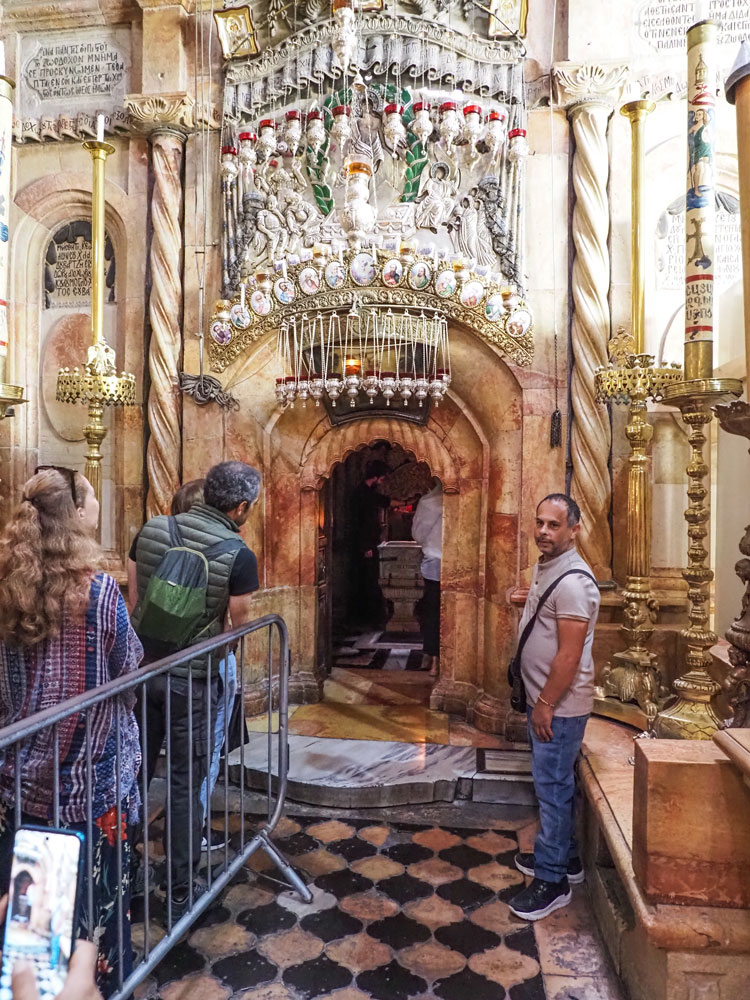
The dome over the Aedicule, with the Oculus to let light in.
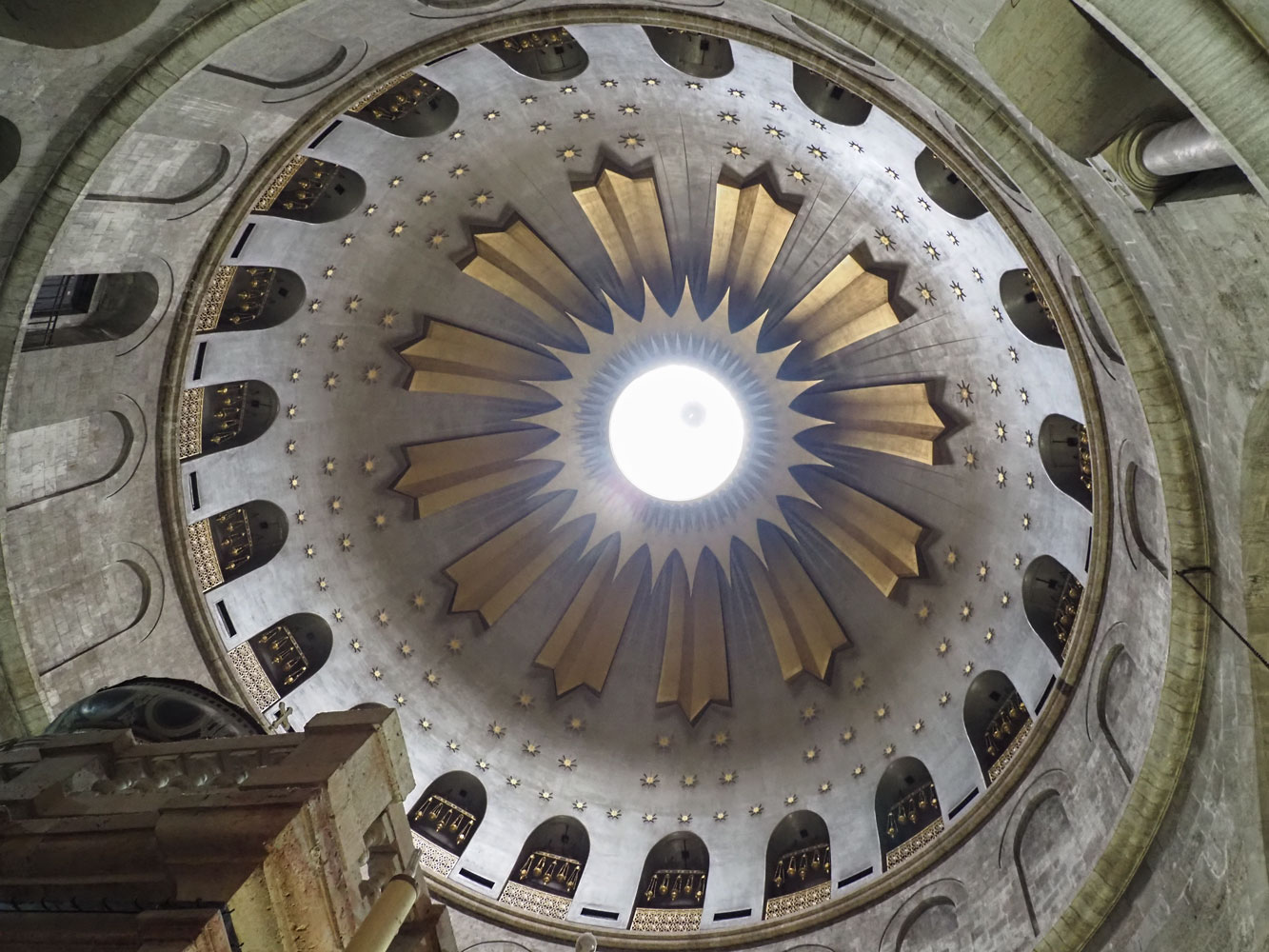
Off of the main dome area is the Chapel of the Apparition.
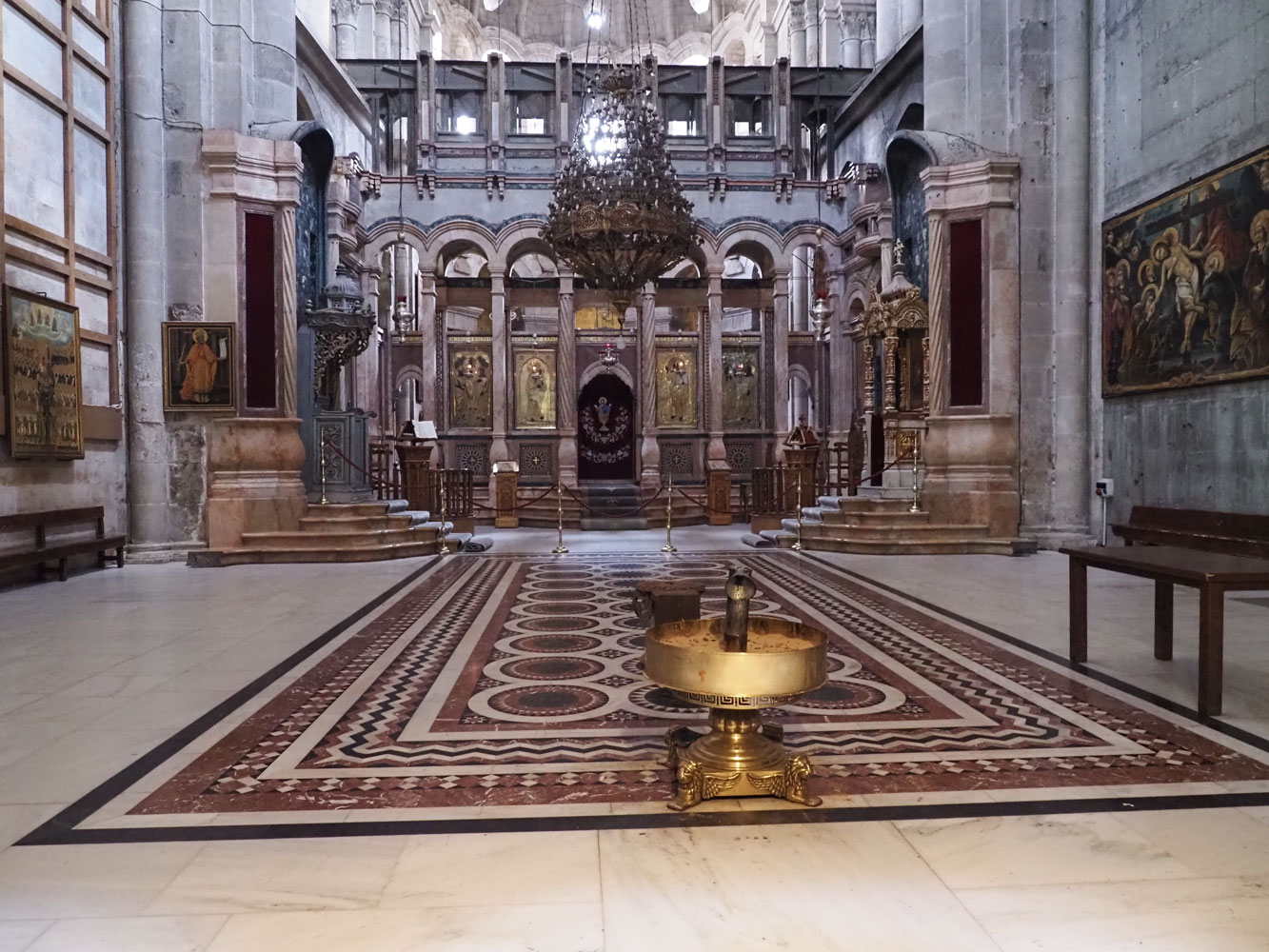
The dome over the Chapel of the Apparition.
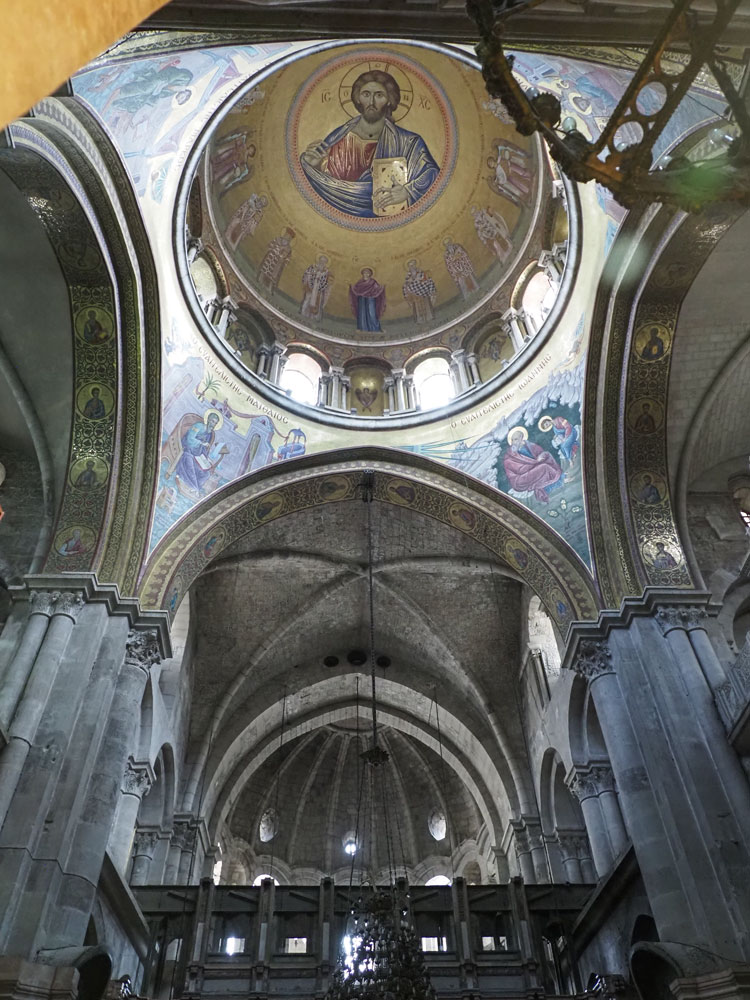
The Greek Orthodox Catholicon.
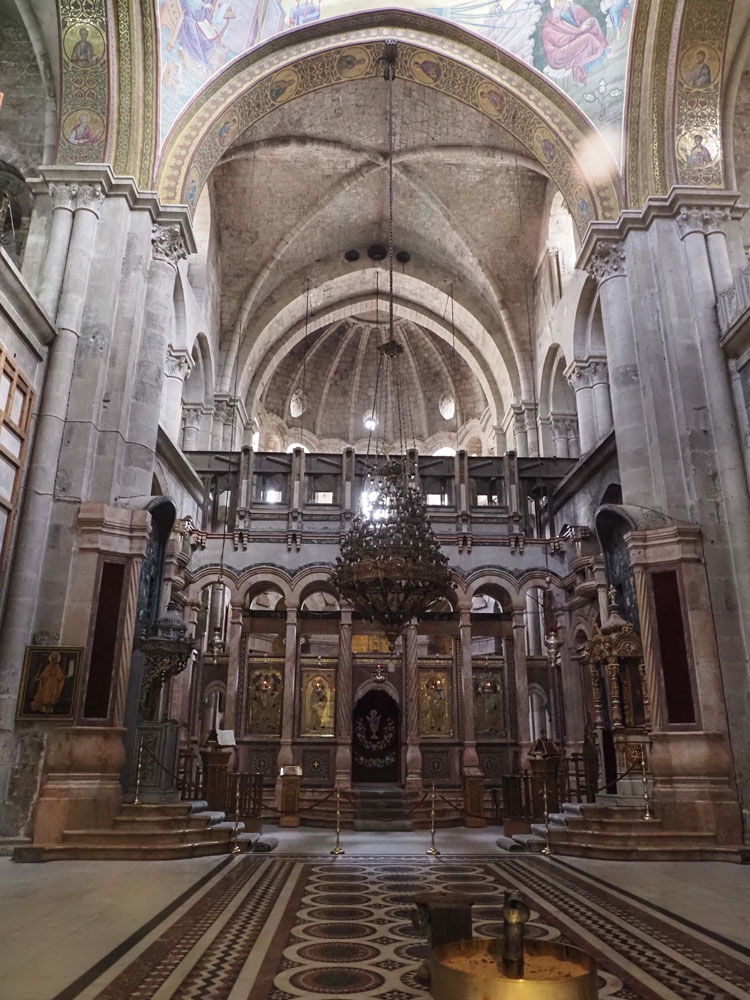
I took a lot more pictures, but this is enough for the blog. We exited the church at this time and walked to the Jaffa Gate and out of the Old City.
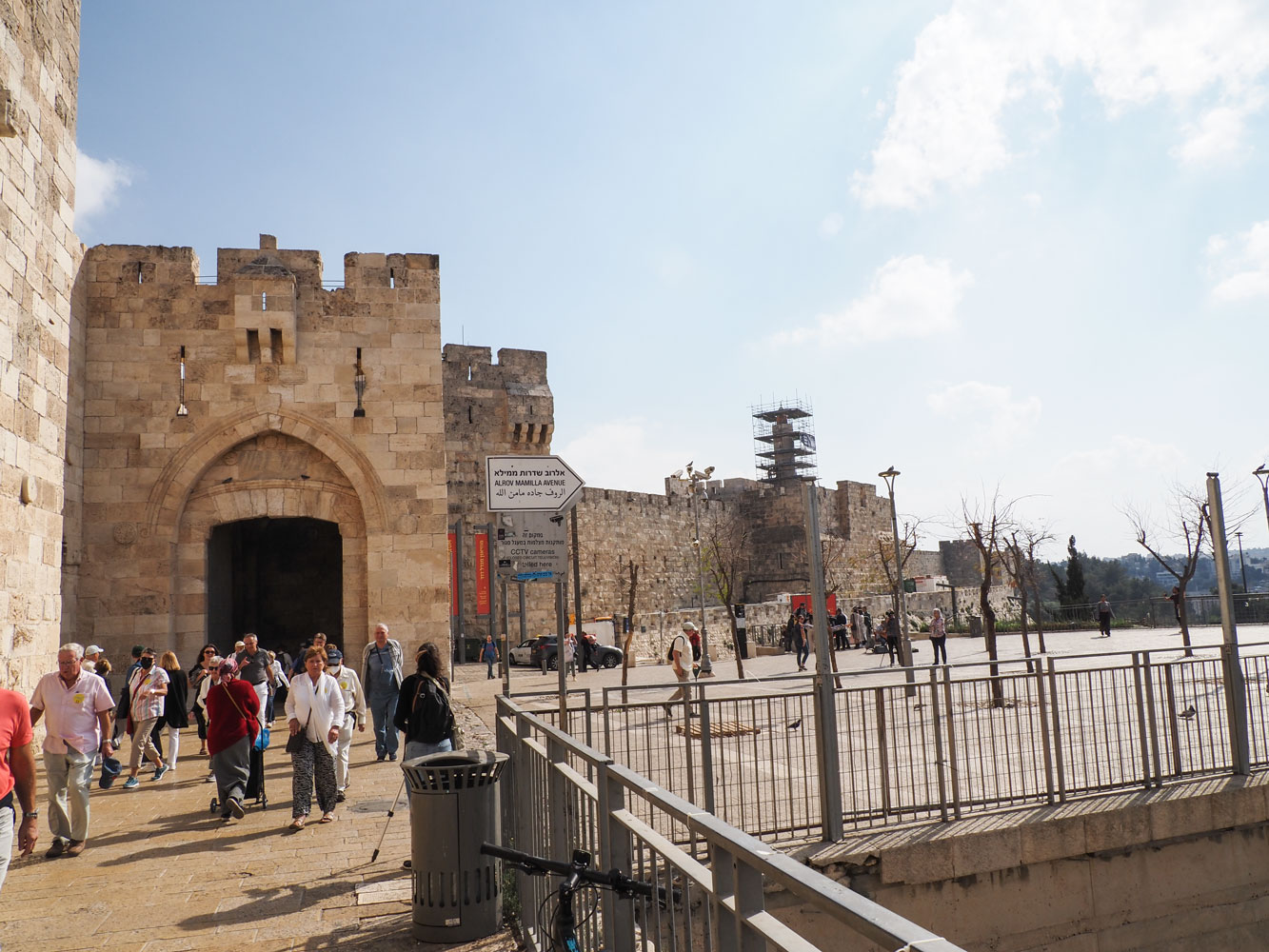
We took the bus to the Olive Tree Hotel for lunch. It was a nice buffet restaurant and the food was very good.
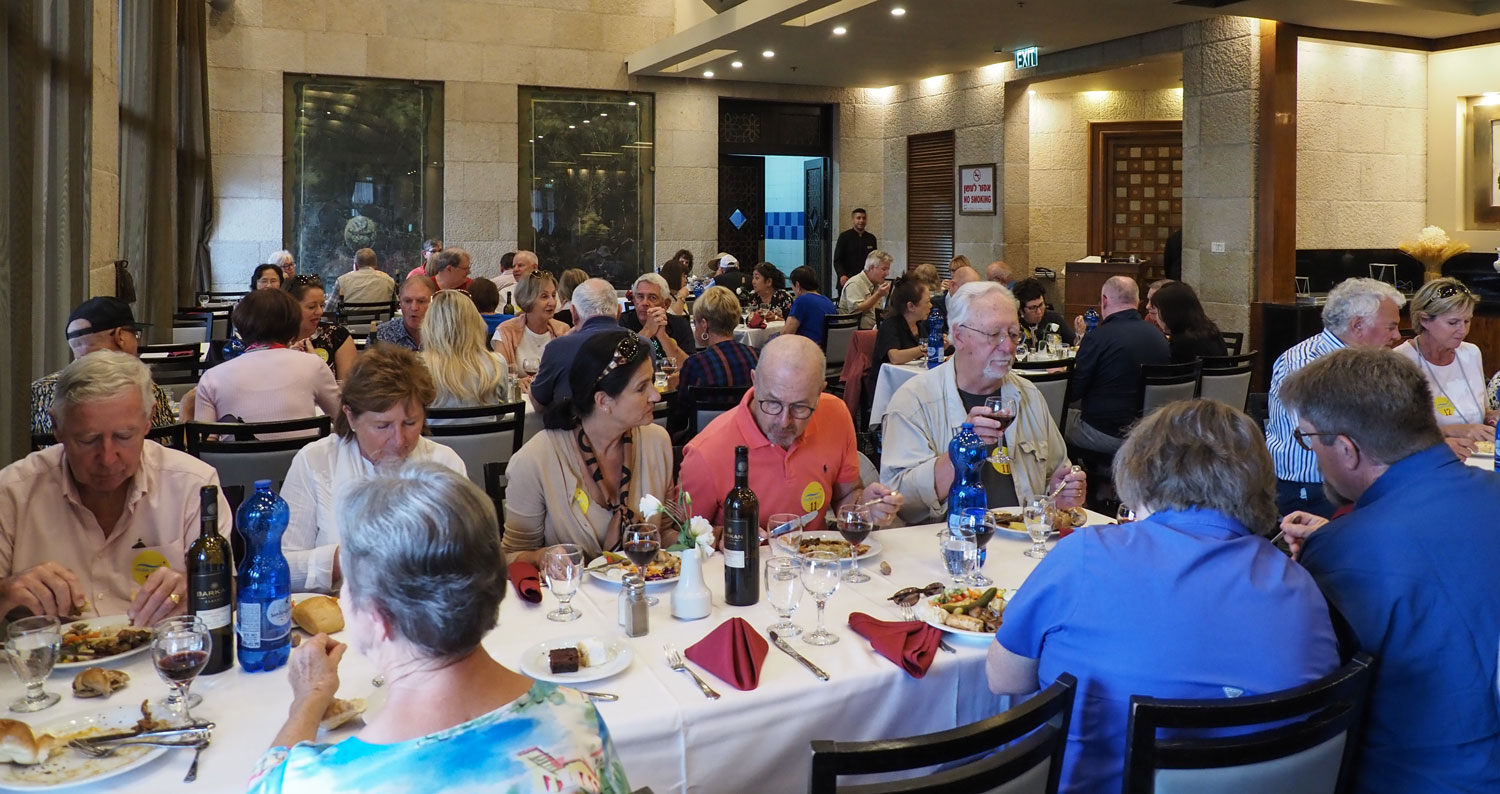
After lunch the bus took us to Mount Scopus and we were able to take some pictures of the Old City. However, the Old City was quite some distance away and there was a lot of water vapor in the air, making it difficult to get good pictures. This picture was highly processed in PhotoShop just to get this quality.

With that, our tour was over and we headed back to the ship - a bit more than an hour's drive.